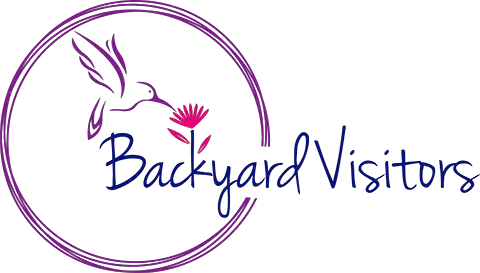This post contains affiliate links.
Arizona, known as The Copper State or The Grand Canyon State, is home to three species of hummingbirds out of the sixteen species listed for this state. The hummingbird season in Arizona peaks during the spring and summer months from March to August.
What species of hummingbirds are found in Arizona?
There are 16 species of hummingbirds found in Arizona.
Anna’s, Allen’s, Berylline, Black-chinned, Blue-throated (Blue-throated Mountain-gem), Broad-billed, Broad-tailed, Calliope, Costa’s, Green-violetear (Mexican-violetear), Lucifer, Rivoli’s (Magnificent), Ruby-throated, Rufous,
Violet-crowned, and White-eared.
The climate of Arizona is semi-arid to semi-arid tropical and is an environment that sustains large vegetational forests with minimal rainfall. It is a step up from a desert climate. Plants that live in these regions include grasses, small shrubs with thorny branches or succulents that retain water.
The people of Arizona love hummingbirds and know to visit Ramsey Canyon Preserve, also known to be the “Hummingbird Headquarters” of the United States. It is located in southeastern Arizona close to the border of Mexico. This grand diverse ecosystem is home to an array of plant and animal habitats. The Rivioli’s and Anna’s hummingbirds are commonly seen here.
There are 3 categories of hummingbirds found in Arizona.
Year-round/Native Hummingbirds:
This hummingbird classification is defined as hummingbirds not migrating and residing in Arizona 365 days a year as a group.
- Anna’s
- Black-chinned
- Costa’s
Seasonal Hummingbirds:
These hummingbirds reside in Arizona temporarily as part of their migratory pattern. Some of each of these species spend the entire spring, summer and fall in Arizona while others of this migratory group may travel to more northern states during the summer.
- Blue-throated (Blue-throated Mountain-gem)
- Broad-billed
- Broad-tailed
- Calliope
- Rivoli’s (Magnificent)
- Rufous
- White-eared
Rare/Vagrant Hummingbirds:
Hummingbirds in this classification are defined as hummingbirds residing in a group outside of their normal geographic range. Not only do these species of hummingbirds have a wide variety of specific geographic ranges, they are also known to sometimes interbreed with each other, creating hybrids.
- Allen’s
- Berylline
- Calliope
- Green-violetear (Mexican-violetear)
- Lucifer
- Ruby-throated
- Violet-crowned
Read on to find out more about each of these hummingbird species as well as where and when they can be found in Arizona.
Year-round/Native Hummingbirds
ANNA’S HUMMINGBIRD – (Calypte anna)
Conservation Status: Least concerned
Kingdom: Animalia
Phylum: Chordata
Class: Aves
Order: Apodiformes
Family: Trochilidae
Genus: Calypte
Species: C. anna
Anna’s hummingbirds are named after Anna Massena, Duchess of Rivoli. These birds are identified as Native and are commonly seen in the lower elevations of central and southern Arizona.
Saguaro National Park, located in southeastern Arizona in Pima County, states Anna’s hummingbirds are present year-round in the northern regions of the Sonoran Desert. They are also heavily seen in Tucson and Phoenix Arizona.
Male Anna’s hummingbirds are the only hummingbird species in North America with a red crown. They are identified as mostly green, gray, and magenta in color. The males have a flashy and colorful iridescent magenta gorget and crown. Their size ranges from 3.5 inches to 4.3 inches in length and they weigh 2.4 to 4.5 grams.

Photo by: hummingbirdsbysurprise
Taken: Hassayampa River Preserve, Arizona
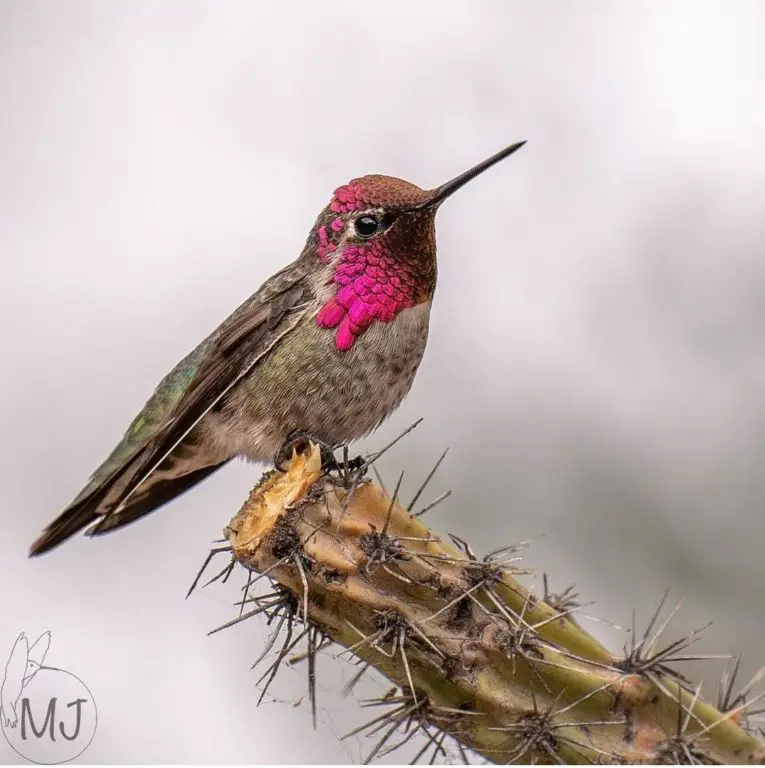
Photo by: hummingbirdsbysurprise
Taken: Hassayampa River Preserve, Arizona
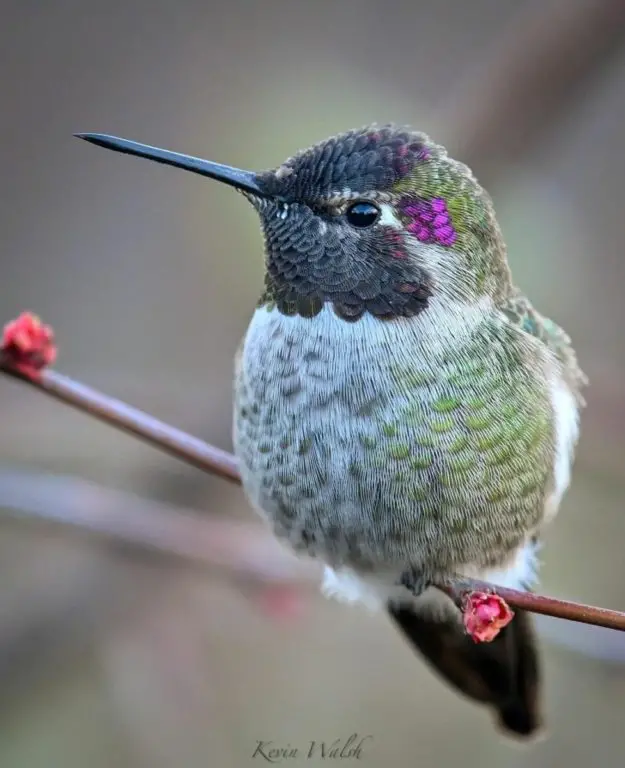
Photo by: Kevin Walsh
The gorget on a male hummingbird is named after the protective metal piece in a suit of armor that covers the wearer’s throat to prevent injury when in battle.
Unlike many northern temperate hummingbirds, male Anna’s hummingbirds sing during courtship (though the song is so high-pitched and squeaky, it’s hard to call it singing).
Female Anna’s hummingbirds are pale green and are not as colorful as the males. They have a distinctive pale white line over each eye which is an identifiable trait.
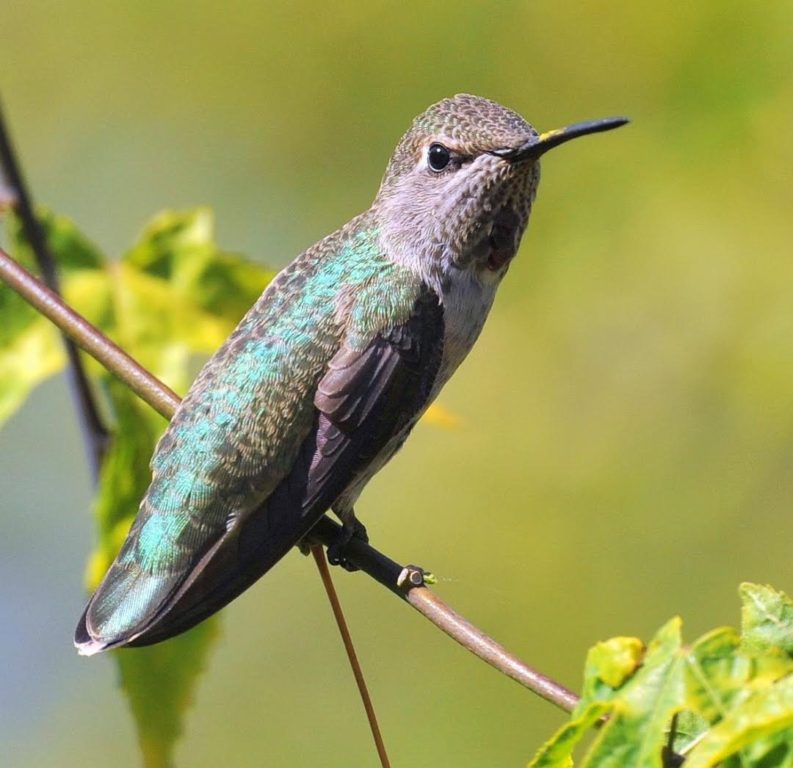
Photo by: rickwmo
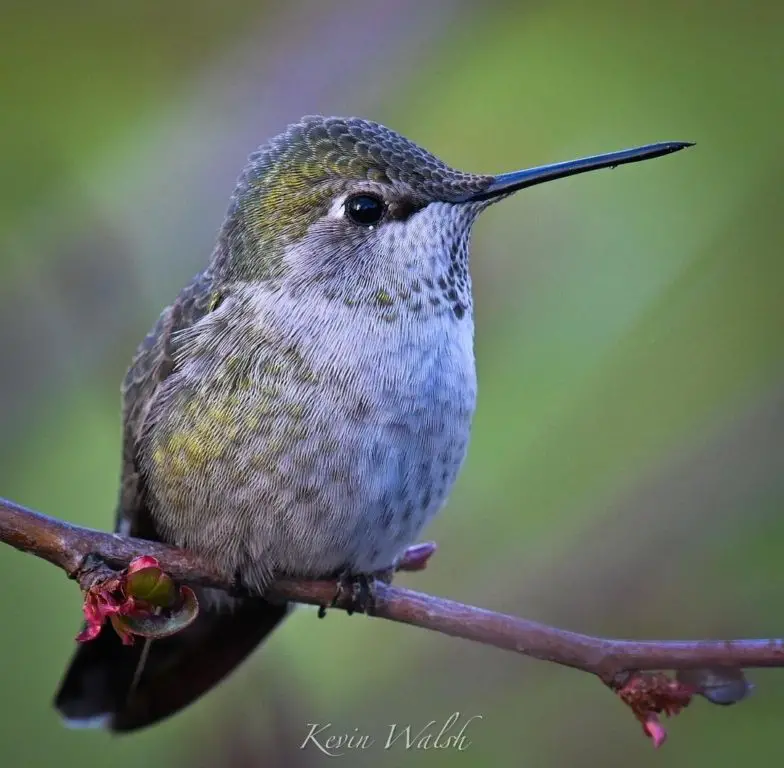
Photo by: Kevin Walsh
They are commonly found nesting in Arizona between January and June. Female Anna’s hummingbirds raise their young with no help from the males.
The Anna’s hummingbirds protect their territory with elaborate dives targeted towards predatory birds and even towards people they perceive to be threatening.
Like Black-chinned hummingbirds, Anna’s hummingbirds hybridize, cross breeding readily with other hummingbird species.
See pictures of male, female and juvenile Anna’s hummingbirds here…..
Hear sounds of Anna’s hummingbirds here…..
BLACK-CHINNED HUMMINGBIRD – (Archilochus alexandri)
Conservation Status: Least concerned
Kingdom: Animalia
Phylum: Chordata
Class: Aves
Order: Apodiformes
Family: Trochilidae
Genus: Archilochus
Species: A. alexandri
Black-chinned hummingbird’s scientific name is in commemoration of Dr. Alexandre, a French doctor who was the first to discover the species in Mexico. They are Native to Arizona, however they can be readily seen in abundance through migration between the months of April through September. By October, they leave to over-winter in southern and western Mexico.
Male Black-chinned hummingbirds are identified by their royal purple gorget, showing a small glimmer of color right near the neckline like a buttoned-up shirt. Since the male purple gorget or throat color is minimal, at times they can appear to look all black. They have metallic green on their backs and flanks with white on their underbelly. Their dark tail is forked and their bill is black. Their size is 3.25 inches to 3.5 inches in length and weigh 2.8-5.6 grams.
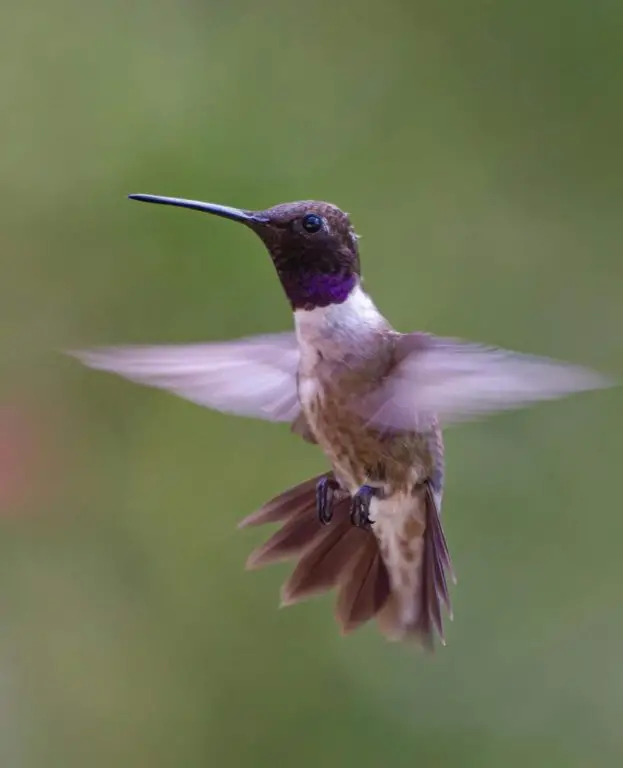
Photo by: Aaron Gomperts
Taken: Madera Canyon, Arizona
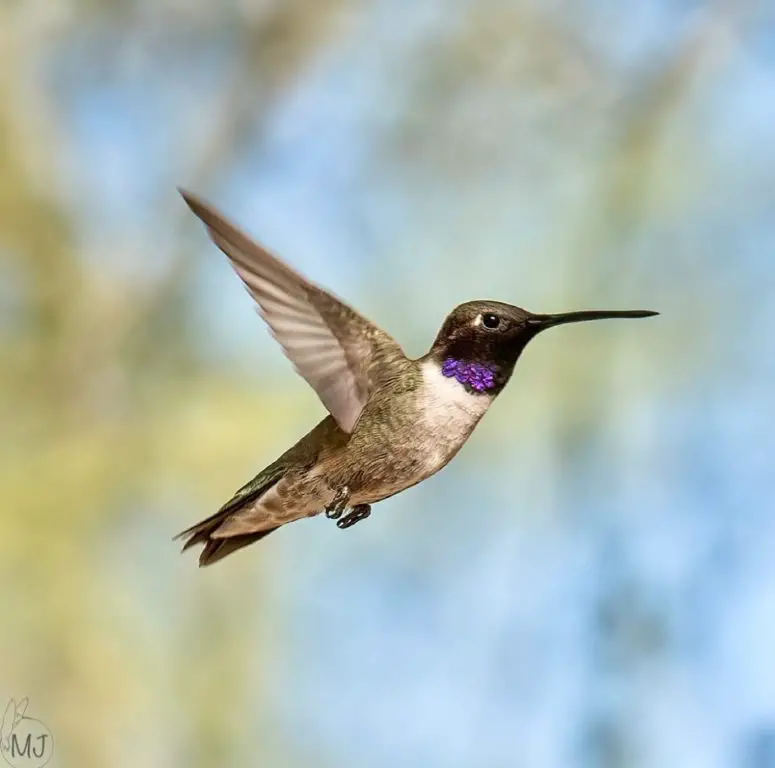
Photo by: hummingbirdsbysurprise
Taken: Hassayampa River Preserve, Arizona
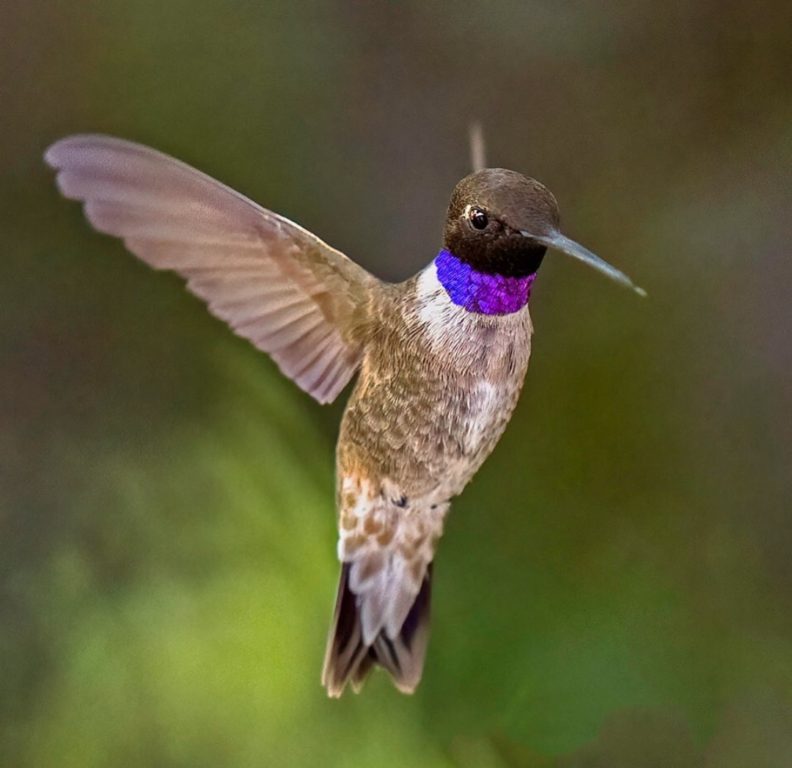
Photo by: sony_alpha_male
The gorget on a male hummingbird is named after the protective metal piece in a suit of armor that covers the wearer’s throat to prevent injury when in battle. Since male hummingbirds are very aggressive with each other when fighting for their own territory, this name is appropriate and fitting to describe their physical attributes.
Female/juvenile Black-chinned hummingbirds have no gorget, but have a dark rounded tail with white tips and beige margins on the dorsal feathers that turn dark black as they mature. Their head and back reflect the dull metallic marbled colors of beige, greens, whites, yellow-green and dark browns, looking similar to the scales found on a snake.
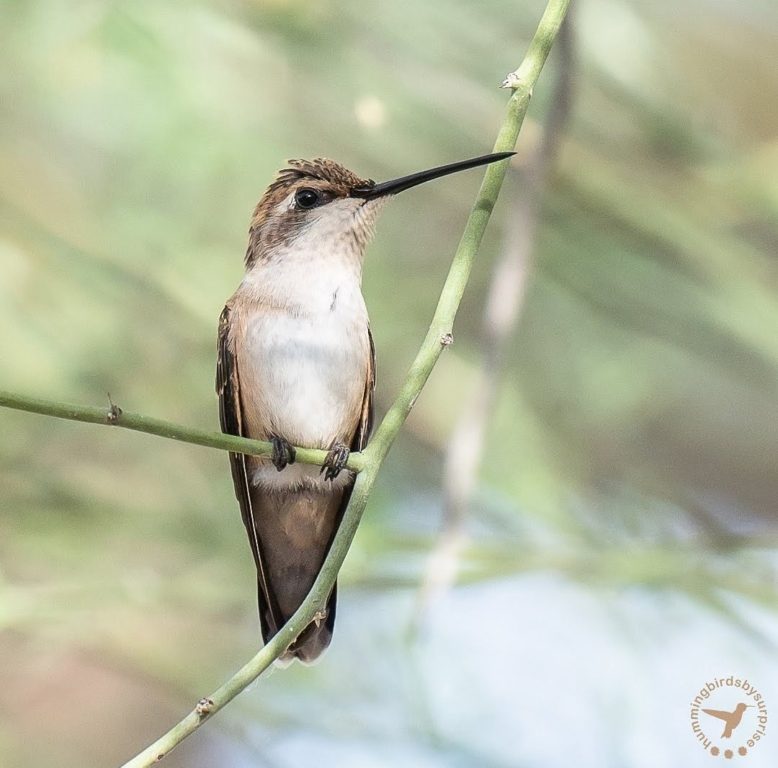
Photo by: hummingbirdsbysurprise
Black-chinned hummingbirds breed east of the Cascade mountain range and in Arizona. Their breeding grounds and habitat are closely related to the Ruby-throated hummingbird.
They hybridize and readily crossbreed with other hummingbird species. Black-chinned hummingbirds can live up to 10 years, which is extremely long in comparison to other birds and animals of similar size.
Because of their small size, Black-chinned hummingbirds are at risk of being preyed-upon by larger insect-eating birds or larger insects such as a praying mantis. Black-chinned hummingbirds are known to use a decoy strategy by constructing their nest near larger and more active bird’s nests reducing the chance of predators around their nest.
See my article: 10 Common Things That Kill Hummingbirds
While typically a territorial species, if Black-chinned hummingbirds find themselves in an area with a large population of hummingbirds and food sources of plenty, their territorial behaviors will reduce and they will play nice and share.
Black-chinned hummingbirds have the smallest known genetic material of all living vertebrates or mammals.
See pictures of male, female and juvenile Black-chinned hummingbirds here…..
Hear sounds of Black-chinned hummingbirds here…..
COSTA’S HUMMINGBIRD – (Calypte costae)
Conservation Status: Least concerned
Kingdom: Animalia
Phylum: Chordata
Class: Aves
Order: Apodiformes
Family: Trochilidae
Genus: Calypte
Species: C. costae
Costa’s hummingbird was named in 1839 by Jules Bourcier to commemorate Louis Marie Pantaleon Costa, the French ornithologist who was an avid collector of hummingbirds.
They are considered Native because they are common year-round residents in the west and southwestern Arizona. However, there is a group that migrates into southeastern Arizona in February then leave to migrate south in the fall.
According to Kofa National Wildlife Refuge, there are five species of hummingbirds found here that include: Costa’s, Black-chinned, Anna’s, Broad-tailed and Rufous hummingbirds.
Male Costa’s hummingbirds have a bright reddish-purple cap and gorget. Their gorget has long streaming throat feathers, similar to a Calliope hummingbird. Having green backs and flanks, their back and wings are black and their throat and tail have patches of white. Their size ranges from 3 inches to 3.5 inches in length and weighs 2-3 grams.
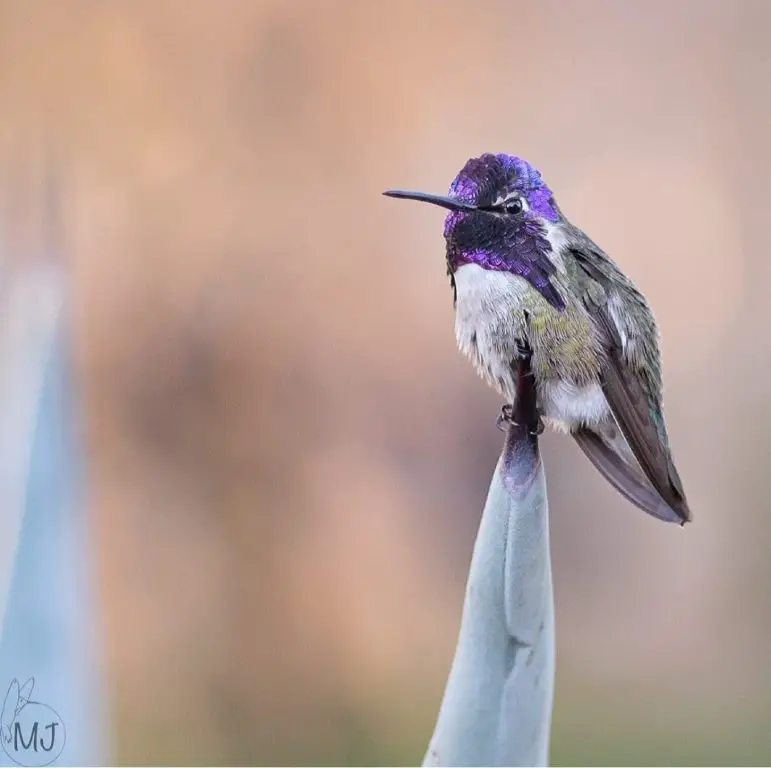
Photo by: hummingbirdsbysuprise
Taken: Surprise, Arizona
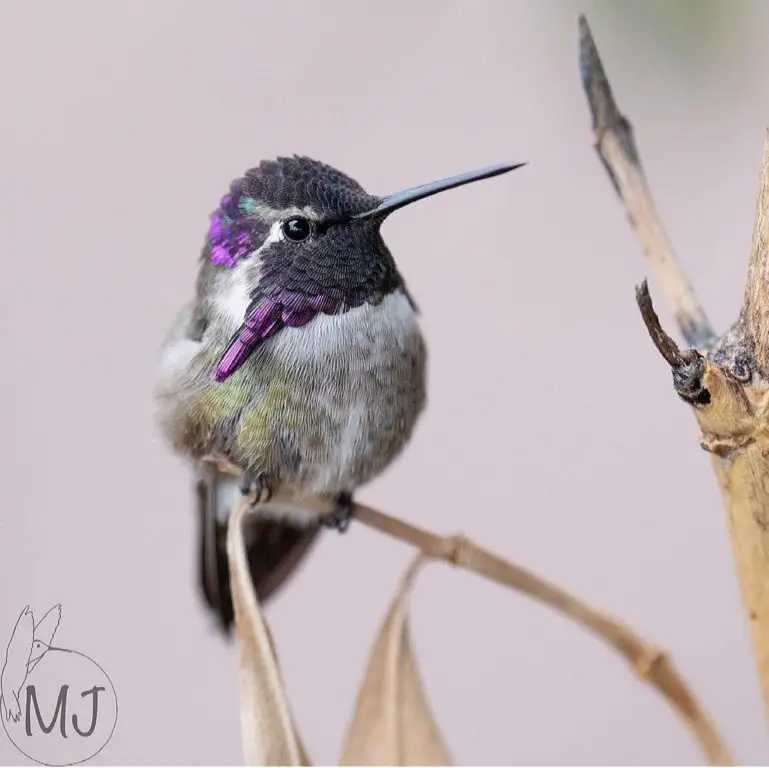
Photo by: hummingbirdsbysuprise
Taken: Surprise, Arizona
Adult female Costa’s hummingbirds are not as vibrant and display in color, a grayish-light green back with a dusty white underbelly.
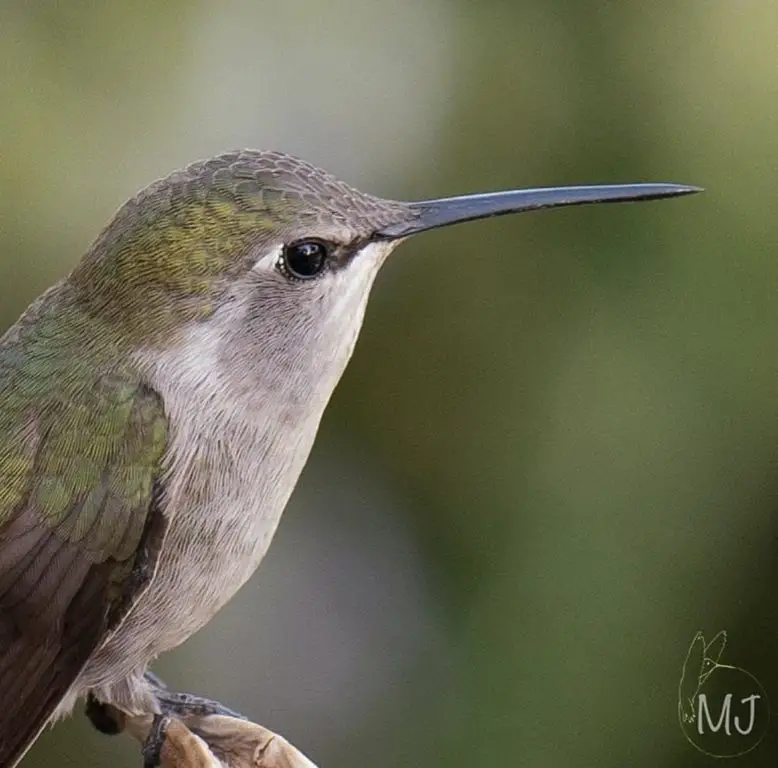
Photo by: hummingbirdsbysuprise
Taken: Surprise, Arizona
Female Costa’s hummingbirds migrate north to breed. They are a desert-dwelling species and build their nests in open areas with scarce vegetative cover. They have been known to nest on the tops of cacti. The thorns of the plant act as a deterrent to predators that may attempt to eat the eggs or nestlings.
Their habitat consists of desert scrub and washes including grasslands where they thrive on desert plants or ocotillos.
Costa’s hummingbirds are a desert-dwelling species and build their nests in open areas with scarce vegetative cover. They have been known to nest on the tops of cacti. The thorns of the plant act as a deterrent to predators that may attempt to eat the eggs or nestlings.
Male Costa’s hummingbirds are extremely territorial and can come across as being the meanest sheriff in town, especially when defending “their” feeders. Their aggressive conduct is equivalent to the known quarrelsome and combative behaviors of the Rufous hummingbird.
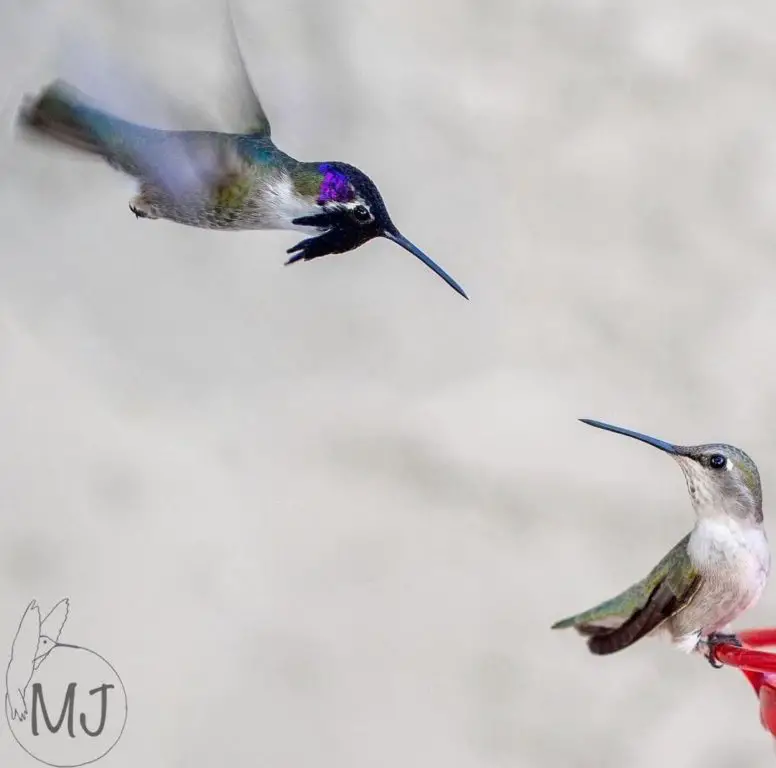
Photo by: hummingbirdsbysuprise
Taken: Surprise, Arizona
These hummingbirds have no known predators, however, the largest threat to Costa’s hummingbirds is human encroachment in the form of the desert being plowed and cleared for settlement and grazing.
They are known to interbreed and produce hybrids between Anna’s, Black-chinned and Blue-throated hummingbirds.
See pictures of male, female and juvenile Costa’s hummingbirds here…..
Hear sounds of Costa’s hummingbirds here…..
Seasonal Hummingbirds
BLUE-THROATED HUMMINGBIRD – (Lampornis clemenciae)
Conservation Status: Least concerned
Kingdom: Animalia
Phylum: Chordata
Class: Aves
Order: Apodiformes
Family: Trochilidae
Genus: Lampornis
Species: L. clemenciae
The Blue-throated hummingbird (also known as a Blue-throated Mountain-gem) is a species of hummingbird Native to the woodland mountains of Mexico however are considered Seasonal to Arizona because they are commonly spotted from April through October. It is possible to see them year-round in southeastern Arizona where they are mostly noticed around feeders. This variety breeds in the late spring through the summer and the majority of them will migrate south to Mexico by October.
Male Blue-throated hummingbirds feature a bright iridescent cobalt blue gorget, with dramatic white stripes over both of its eyes. His wings and tail are dark brown with painted white tips on his tail. Blue-throated hummingbirds expose a dull greenish-gray color all over its body emphasized by patches of greyish-emerald green on their head, neck, and the top part of the shoulder where the wings attach. They are a large hummingbird that ranges from 4.5 inches to 4.9 inches in length and weighs 8.1 to 8.6 grams.
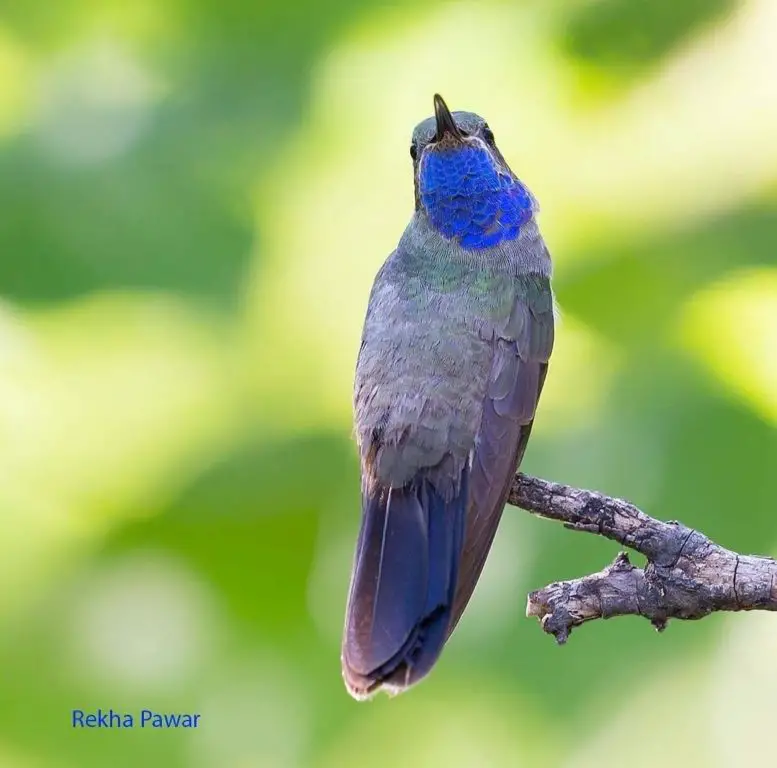
Taken: Portal, Arizona
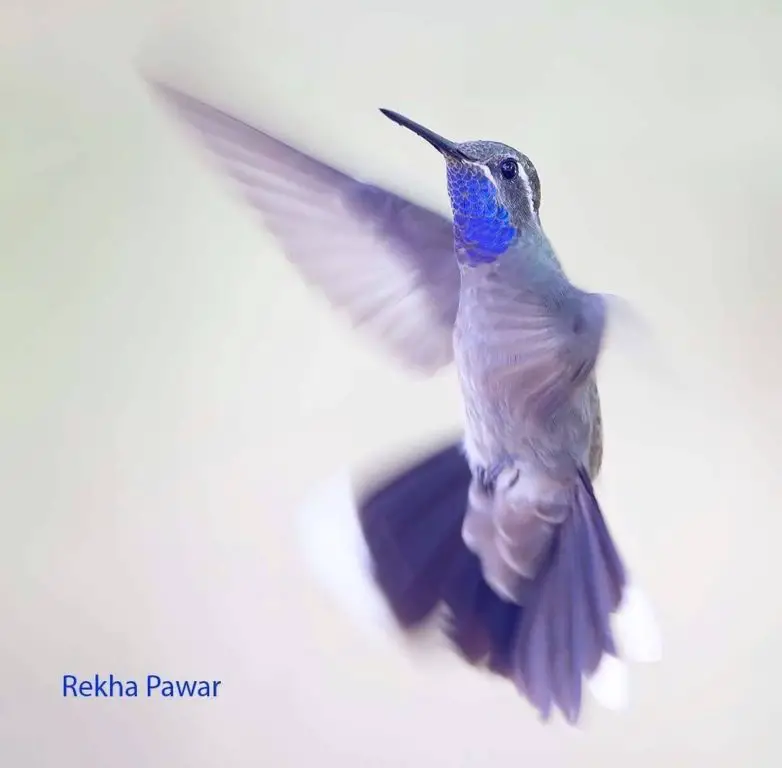
Taken: Portal, Arizona

Taken: Portal, Arizona
Partially because of their large size, Blue-throated hummingbirds have the slowest recorded wing beat rate of any known hummingbird. It beats its wings 23 times a second while hovering compared to the average 53 beats per second. The hummingbird with an extended wingspan requires more effort to move its wings in a figure-eight motion than a hummingbird with a smaller wingspan.
Blue-throated hummingbirds are mountainous birds that prefer to nest on rock overhangs or on human residential structures. They are known to return to the same nest each year, stacking new nests on top of old nests resembling a tall tower.
They are territorial and aggressive while protecting flowers with a high sugar content and will violently defend them from invaders. They are heavily insectivorous due to the energy necessities of their size, and as a result, eat more insects than any other hummingbird species.
Blue-throated hummingbirds are known to interbreed and produce hybrids between Anna’s and Black-chinned hummingbirds.
See pictures of male, female, and juvenile Blue-throated hummingbirds here…..
Hear sounds of Blue-throated hummingbirds here…..
BROAD-BILLED HUMMINGBIRD – (Cynanthus latirostris)
Conservation Status: Least concerned
Kingdom: Animalia
Phylum: Chordata
Class: Aves
Order: Apodiformes
Family: Trochilidae
Genus: Cynanthus
Species: C. latirostris
Broad-billed hummingbirds are Seasonal to Arizona and travel frequently to the United States near the southern Mexican border. They are seen arriving in late March and usually migrate down south by October. They are commonly seen in spring around the riparian woodlands and mesquite washes in southeastern Arizona. There may be a few stragglers year-round staying close to feeders.
Male Broad-billed hummingbirds feature a bright blue-green gorget that spreads back towards its shoulders. Juvenile males show off a full charcoal dark grey body with flecks of metallic blue on their throat and a light green neck and backside. They sport a long beak that is bright orange-red accented with a signature black tip. Their size ranges from 3.25 inches to 4 inches in length and weighs 3-4 grams.
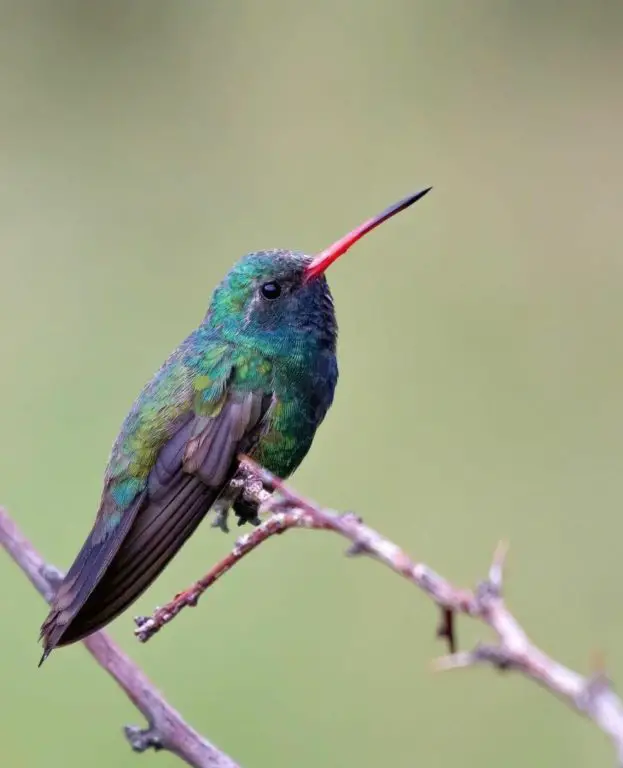
Photo by: Aaron Gomperts
Taken: Madera Canyon, Arizona
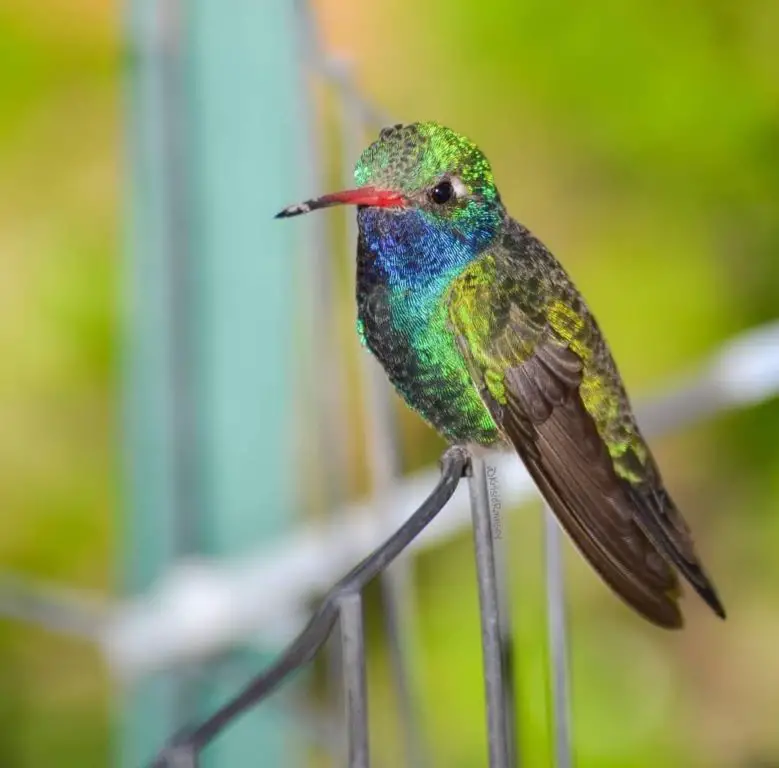
Photo by: krisieramsey
Taken: Green Valley, Arizona
Female Broad-billed hummingbirds are identified with a completely dark bill and a longer white accent above the eyes.
Juvenile male and female Broad-billed hummingbirds are both predominantly metallic green on their topside with a white underbelly. Their tails are dark in color and forked.
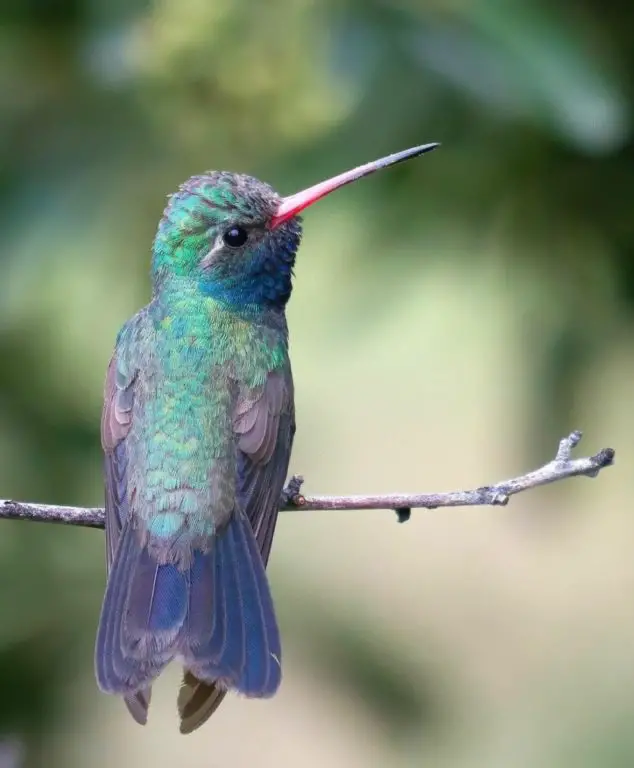
Photo by: Aaron Gomperts
Taken: Madera Canyon, Arizona
Broad-billed hummingbird nests are distinguishable because they do not decorate the outside of their nests with lichens but instead choose to construct their nests with outside grass fibers, bits of leaves and bark while using spider webs to glue and hold the nest together. The nest that the female builds hangs on a single long slender branch.
Astonishingly, unlike other hummingbird population counts, the Broad-billed hummingbird has shown an actual general population increase in recent years.
In Arizona, the oldest recorded male Broad-billed hummingbird was 9 years and 1 month old when he was captured and released from a banding operation.
See my article: 3 Reasons Why Hummingbirds Are Banded
See pictures of male, female, and juvenile Broad-billed hummingbirds here…..
Hear sounds of Broad-billed hummingbirds here…..
BROAD-TAILED HUMMINGBIRD – (Selsaphoris platycercus)
Conservation Status: Least concerned
Kingdom: Animalia
Phylum: Chordata
Class: Aves
Order: Apodiformes
Family: Trochilidae
Genus: Selsaphoris
Species: S. platycercus
The Broad-tailed hummingbird, though usually residing in Mexico and Guatemala during the winter, is a medium-sized Seasonal migrant species who nests in southern Arizona.
They have a migrant and non-migrant population that begins in the south of Mexico. The ones that migrate north to breed will do so in the springtime (ranging from late February to early April) and will pass through Arizona, Colorado, Wyoming, Idaho and reach as far north as Montana.
Below is a Broad-tailed hummingbird’s northbound migration chart.
| Northern Arizona | Early April |
| Colorado | Late April to late May |
| Wyoming | Mid-May |
| Idaho | Late May |
| Montana | Late May |
Once the breeding season is complete, Broad-tailed hummingbirds once again depart and begin their southbound migration to Mexico in late September to winter and meet up with their non-migrant population.
Male Broad-tailed hummingbirds have an iridescent ruby-red gorget. Both males and females have green topside and pale underbellies with bright white eye rings and broadly rounded tails. Their size is medium build and ranges from 3.3 inches to 3.8 inches in length and weighs 3.6 grams.
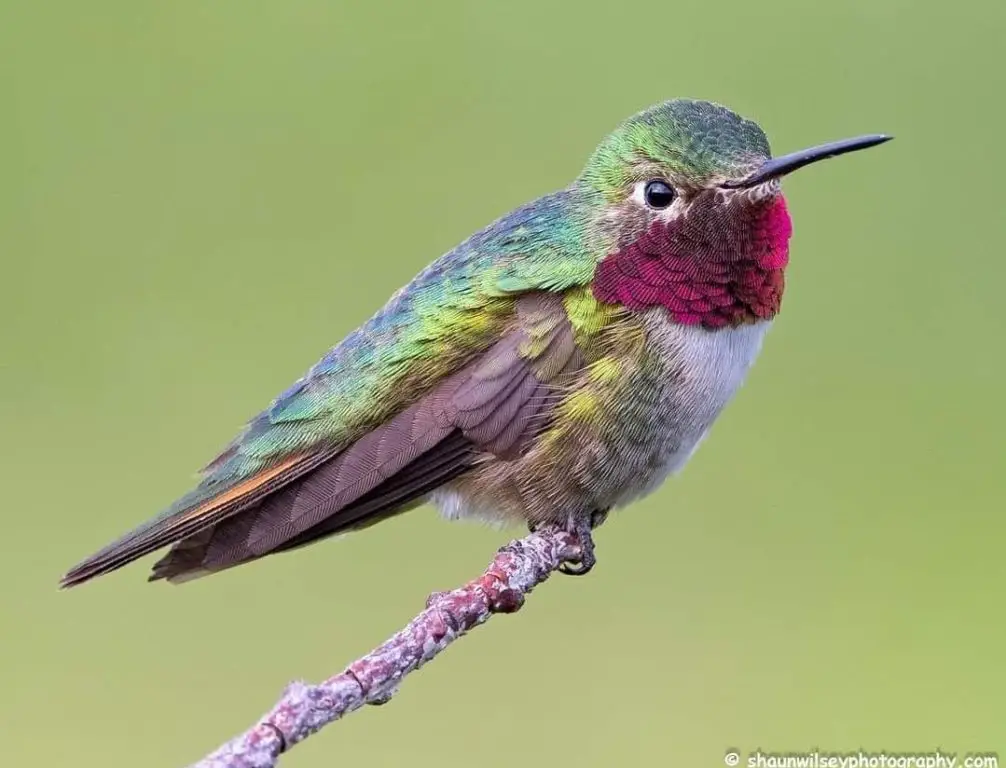
Photo by: shaunwilseyphotography
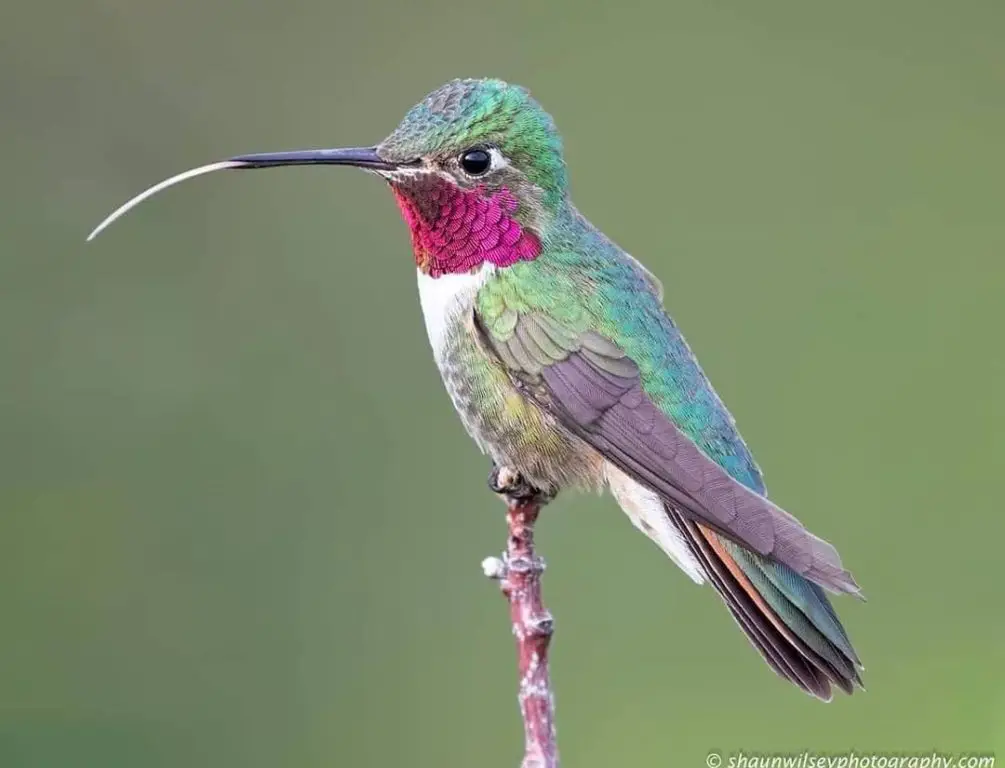
Photo by: shaunwilseyphotography
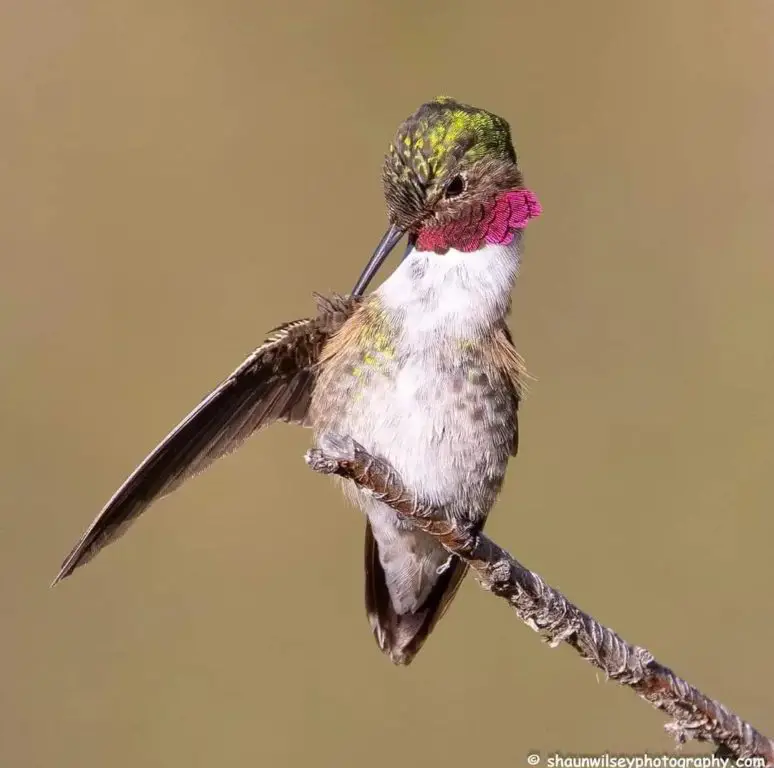
Photo by: shaunwilseyphotography
Note: Preening flight feathers is an important daily routine to maintain hygiene and to keep the feathers flexible, strong, in alignment, and parasite-free.
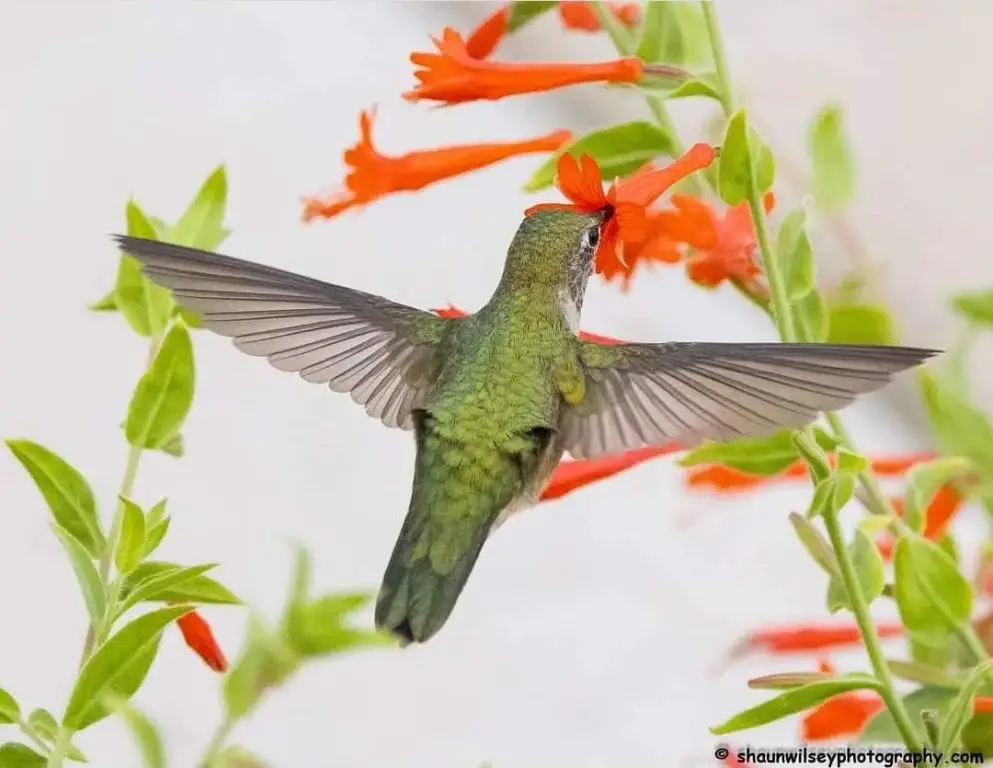
Photo by: shaunwilseyphotography
Note: Hummingbirds beat their wings 80 beats per second. While hovering, the wings move back and forth forming a figure eight or infinity symbol. This powerful movement creates a fanning effect as noticed by the feathers on both sides of her lower back ruffling.
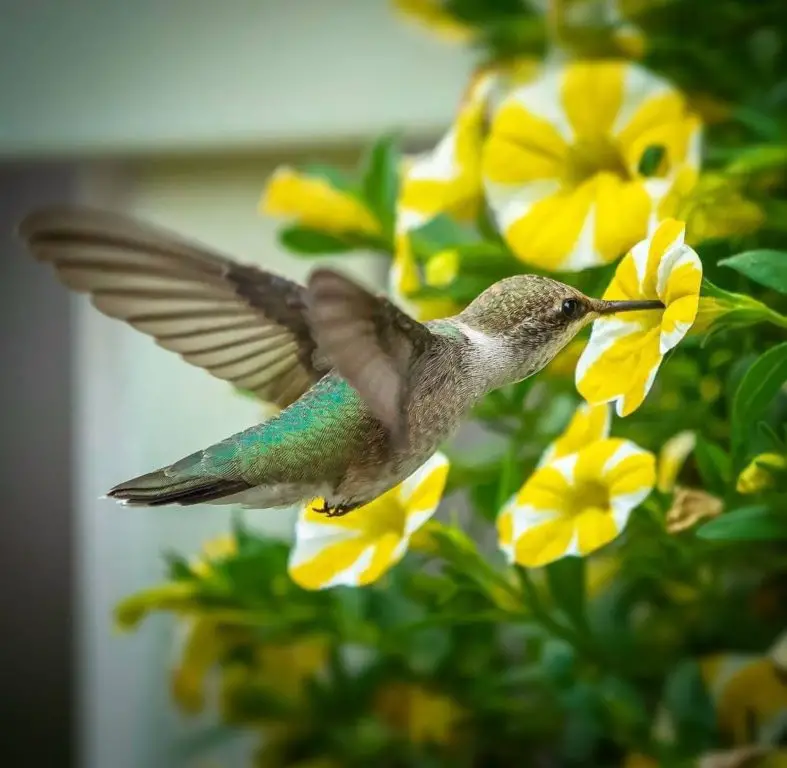
Photo by: sony_alpha_male
This species of hummingbird favors habitats in the understory of mature forest woodlands such as pine and oak groves.
Broad-tailed hummingbirds prefer to nest in juniper shrub or coniferous plants including alder, aspen, cottonwood, scrub oak or willow. All of these have similar superb material properties for nest construction. These birds are known to return to the same nesting ground each year roughly 70% of the time.
Their breeding coincides when the flowering native plants peak for maximum food resource availability. They are promiscuous and do not form any kind of a pair bond between the male and female birds. The females raise the young alone.
The Broad-tailed hummingbird has suffered a decline in population since the 1990’s, but presently, its population is stable, and has adapted to human habitat encroachment.
See pictures of male, female, and juvenile Broad-tailed hummingbirds here…..
Hear sounds of Broad-tailed hummingbirds here…..
CALLIOPE HUMMINGBIRD – (Selasphorus calliope)
Conservation Status: Least concerned
Kingdom: Animalia
Phylum: Chordata
Class: Aves
Order: Apodiformes
Family: Trochilidae
Genus: Selasphorus
Species: S. calliope
Calliope hummingbirds are named after a Greek mythological muse, who represented poetry and eloquence. Calliope means “beautiful voice” in ancient Greek.
They are a rare migrant to Arizona and are seen mostly in the mountains and arrive in the spring as early as April and leave by late September. The rest of the time they winter in Mexico.
Male Calliope hummingbirds are easily identified by their iridescent purple crown and long striking spaced outline row of feathers that project down the sides of their throat. Like many hummingbirds the backs are metallic green and these birds measure 3 inches in length and weigh 2-3 grams.
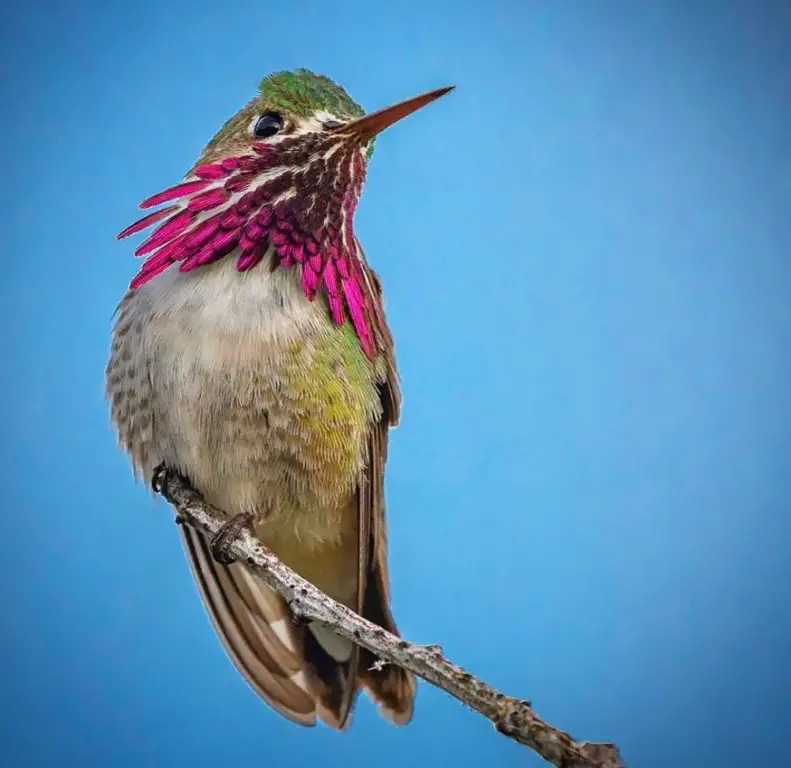
Photo by: sony_alpha_male
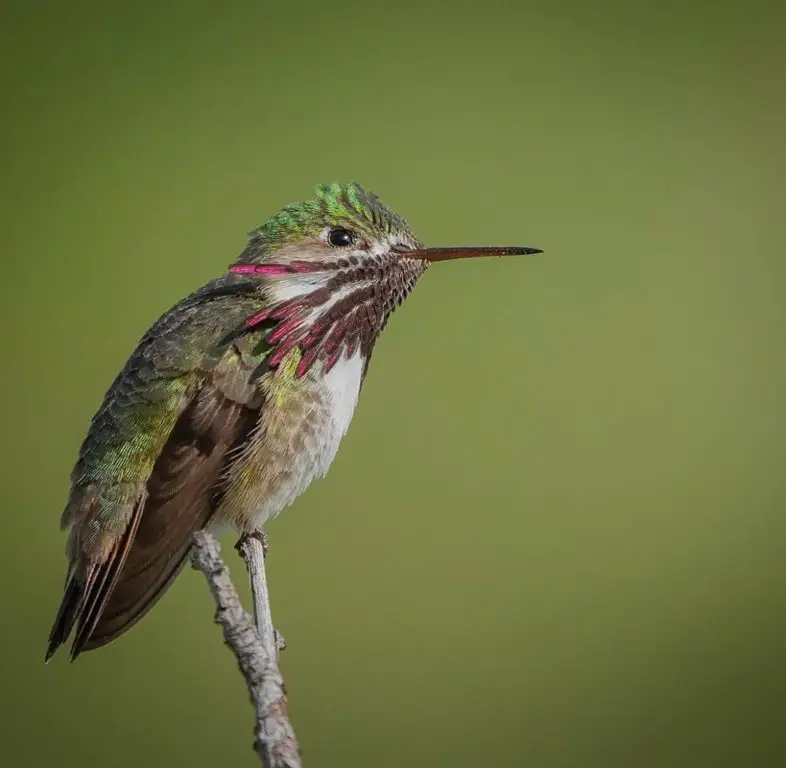
Photo by: sony_alpha_male
Female Calliope hummingbirds have gray-green crowns and buff-colored flanks which are the underbelly or wing of a bird. Females sport dark tails with white tips.
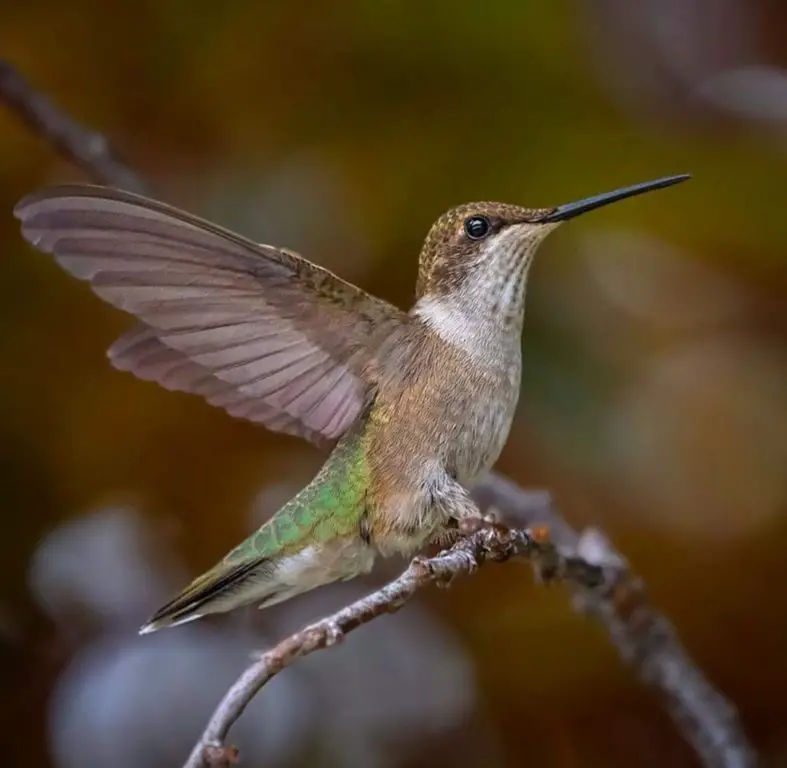
Photo by: sony_alpha_male
Calliope hummingbirds are the smallest long-distance migratory bird in the world. They tend to breed in the higher elevations of the Rocky Mountains.
Like many hummingbirds, Calliopes communicate not just by their song, but also by manipulating their feathers during flight to make different buzzing noises that act as a form of language and communication.
Male Calliope hummingbirds establish a breeding territory and mate with every available female hummingbird that accepts his courtship.
During nest construction, the female Calliope chooses tops of pine cones as her building site. She will also dismantle nests from previous seasons and recycle them in her new nest along with stealing materials from the nests of other birds in order to construct her own. Therefore, female Calliopes are often chased and attacked by larger and more aggressive hummingbirds such as Allen’s and Rufous hummingbirds. To avoid these attacks, the Calliope maintains a relatively low profile in comparison to other species.
Because Calliope hummingbirds have a more restricted wintering range than most hummingbirds, they are particularly vulnerable to habitat loss and natural disasters, such as climate change and wildfires.
During a capture and release banding operation in Idaho, the oldest living recorded female Calliope hummingbird was 8 years and 11 months old when she was captured twice, once in 2007 and again in 2014.
See my article: 3 Reasons Why Hummingbirds Are Banded
See pictures of male, female and juvenile Calliope hummingbirds here…..
Hear sounds of Calliope hummingbirds here…..
RIVOLI’S HUMMINGBIRD – (Eugenes fulgens)
Conservation Status: Least concerned
Kingdom: Animalia
Phylum: Chordata
Class: Aves
Order: Apodiformes
Family: Trochilidae
Genus: Eugenes
Species: E. Fulgens
The Rivoli’s (pronounced: rivo-lee) hummingbird has undergone several name changes. In 1983 it was changed to the “Magnificent Hummingbird”, then to “Refulgent Hummingbird” only to have the “Rivoli’s Hummingbird” name return in 2017 when the species was split into two variations (Rivoli’s and Talamanca). Rivoli’s Hummingbird is named in honor of Francois Victor Massena, the Duke of Rivoli, by the ornithologist Rene-Primevera Lesson.
The Rivoli’s hummingbirds are normally found in the western parts of the United States in the mountainous areas of Arizona, New Mexico, and Central America. They are Seasonal because they arrive in March and leave by November.
Preferring to live in ravines while feeding in open meadows these birds will nest in trees overhanging streams and creeks. They spend the summer in the higher mountains of southeastern Arizona and breed in the late spring then migrate back to western Mexico by November.
Male Rivoli’s hummingbirds are somewhat dark in color except when they are shown in bright daylight, where their violet crown, bright blue-green gorget, and white eyespots are more apparent through iridescence. They are 4.3 to 5.5 inches in length and weigh 6-10 grams. They are considered the second largest hummingbird in the United States.
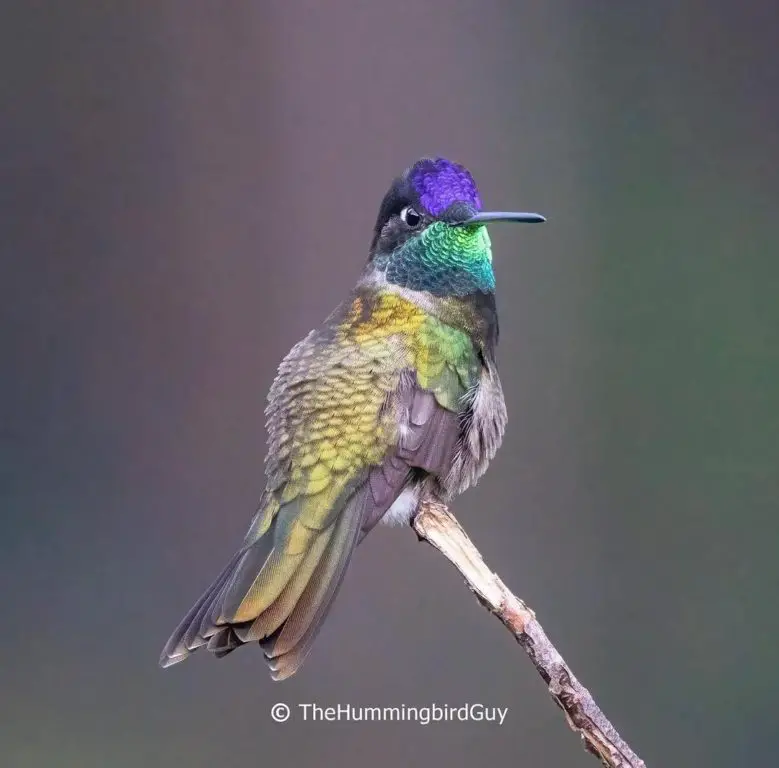
Photo by: TheHummingbirdGuy
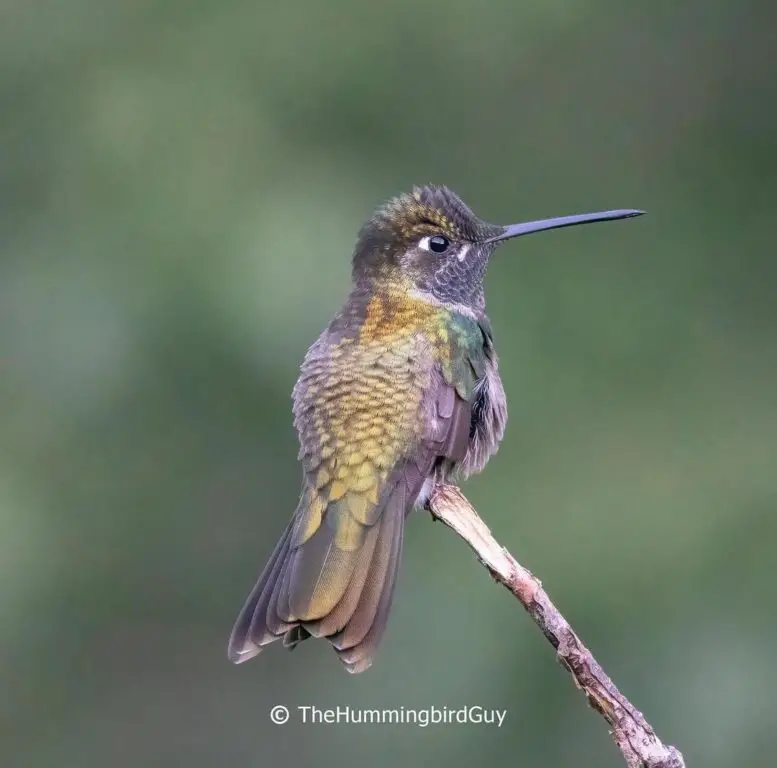
Photo by: TheHummingbirdGuy
Female Rivoli’s hummingbirds prefer to live in ravines while feeding in open meadows. Their breeding habitat consists of building nests in evergreen coniferous trees such as pine, fir and juniper. Female Rivoli’s hummingbirds are located in Oak Creek Canyon (smaller cousin of the Grand Canyon), Mount Lemmon (near the Sonoran desert), Mount Graham (near Tuscan), and Madera Canyon.
These birds will nest in trees overhanging streams and creeks. They spend the summer in the higher mountains of southeastern Arizona and breed in the late spring then migrate back to western Mexico by November.
They have the highest recorded heart rate of any living vertebrate ranging from 420 to 1,200 beats per minute.
Rivoli’s hummingbirds are known for hybridizing with Broad-billed hummingbirds in the southernmost areas of its habitat range.
See pictures of male, female, and juvenile Rivoli’s hummingbirds here…..
Hear sounds of Rivoli’s hummingbirds here…..
RUFOUS HUMMINGBIRD – (Selasphorus rufus)
Conservation Status: Near threatened
Kingdom: Animalia
Phylum: Chordata
Class: Aves
Order: Apodiformes
Family: Trochilidae
Genus: Selasphorus
Species: S. rufous
The Rufous hummingbird gets its name from the Latin word rubrum meaning “red” that is used to describe its reddish-brown coloring. They are Seasonal migrants and are sighted between March through April during spring migration as they pass through western Arizona. They are also sighted between July through mid-October during fall migration as they pass through the entire state in large numbers. These hummingbirds are usually found around feeders in the local gardens.
Male Rufous hummingbirds display an iridescent orange-red gorget with rusty-colored flanks and tail. They have a white to beige underbelly and a black bill. Males can also have green plumage with specks of green color on their rustic looking backs or on the crown of their head along with chocolate brown dorsal feathers. Their size is 2.8 inches to 3.5 inches in length and weighs 3.2 grams.
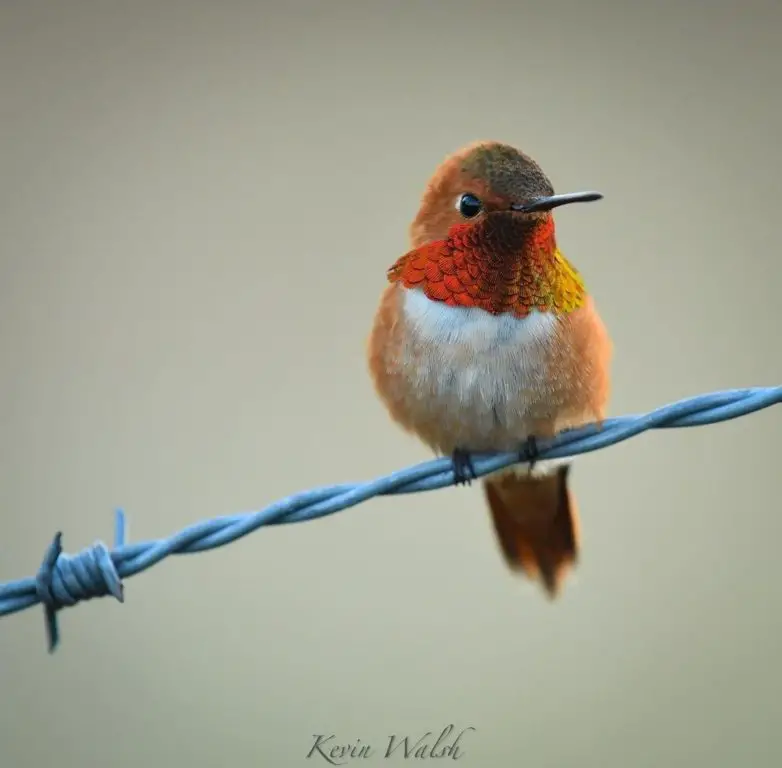
Photo by: Kevin Walsh
Note: The iridescent orange-red gorget.
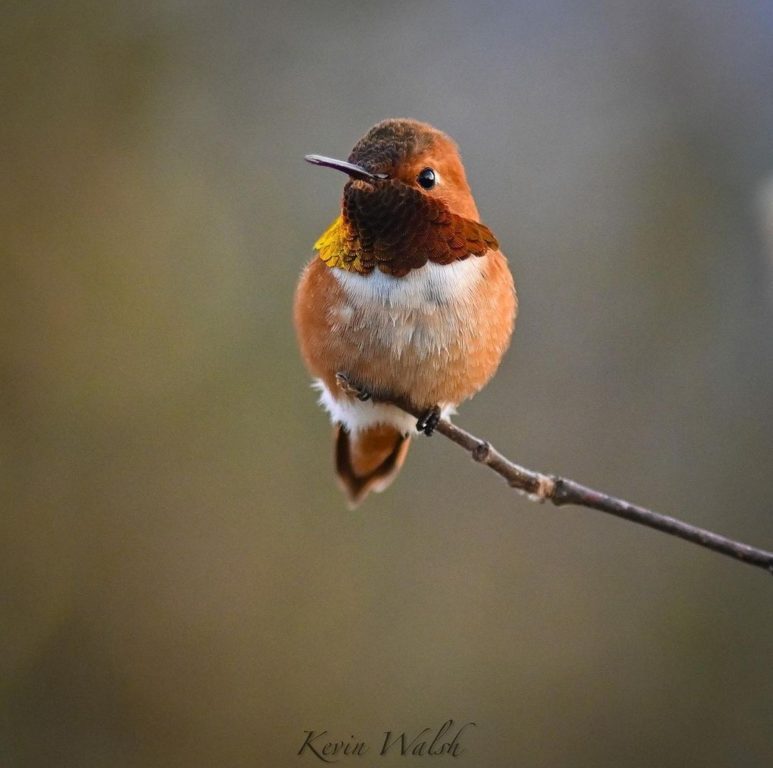
Photo by: Kevin Walsh
Note: The gorget appears chocolate brown in this lighting, however you can still see a glimmer of his iridescent orange-red gorget with some hints of yellow.
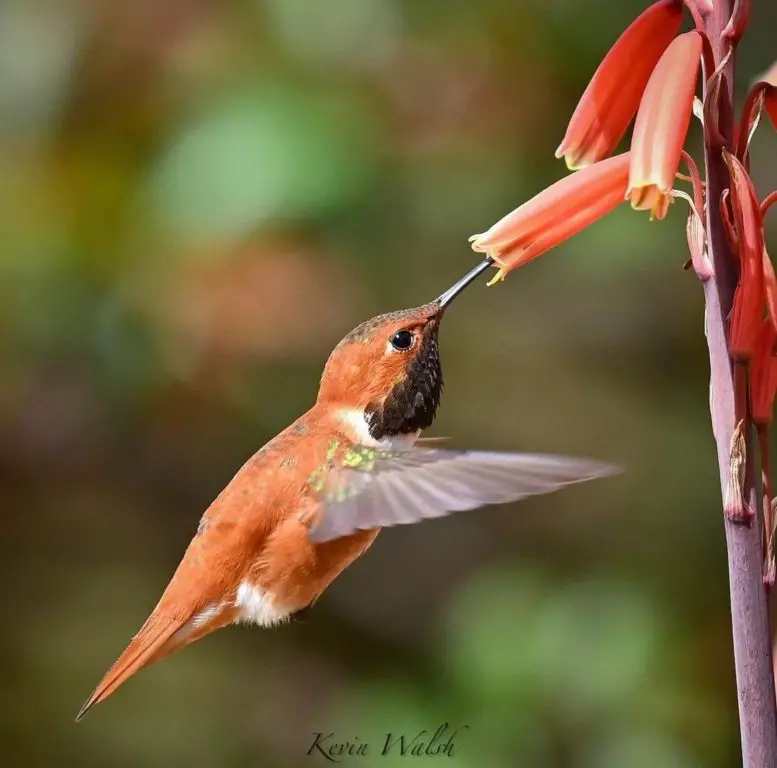
Photo by: Kevin Walsh
Juvenile male Rufous hummingbirds have a rustic look with small iridescent orange specks of color on their throats.
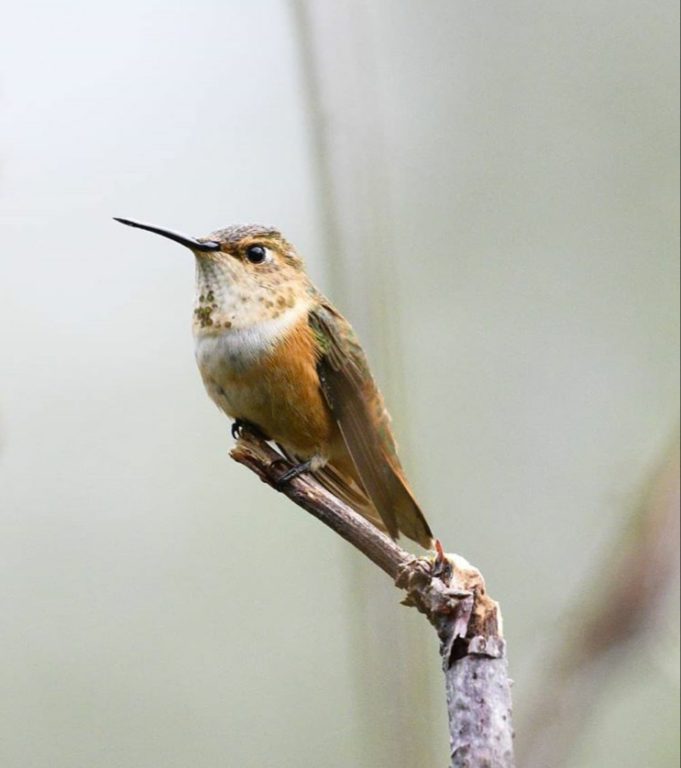
Photo by: jace_the_bird_nerd
Female Rufous hummingbirds are green and white with some iridescent orange feathers on their throat. Their tail is dark with white tips and an orange-red base. Female Rufous hummingbirds are slightly larger than the males in anticipation of producing offspring.
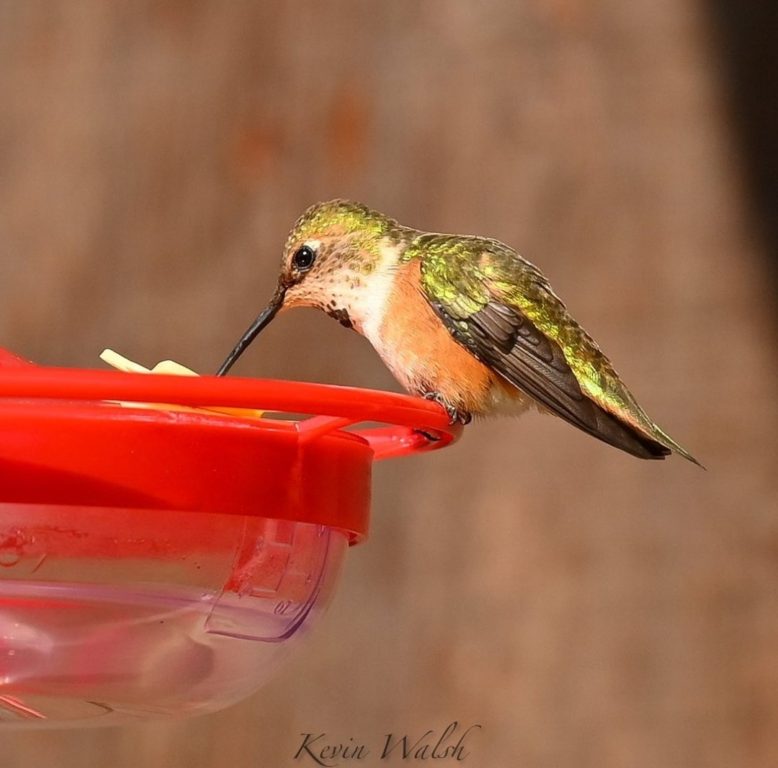
Photo by: Kevin Walsh
They have one of the northernmost breeding ranges of any hummingbird in the world; migrating north from Mexico to Oregon, Washington, Canada and nesting as far north as Alaska to breed during the summer months. They are polygamous and will mate with several partners in a season.
Rufous hummingbirds make the longest migrations of any bird in the world. They travel making a clockwise circuit of western America every year that is approximately 3,900 miles.
Rufous hummingbirds are highly territorial and aggressive towards other hummingbirds and animals. They are fearless and have a reputation for chasing away not only other hummingbirds but even large birds and rodents from their favorite feeders. They have been known to even attack squirrels and chipmunks that come too close to their nest.
Their flying acrobatic skills can outmaneuver all other hummingbird species, making them extremely competitive at feeders.
Rufous hummingbirds have excellent memories and have been known to investigate the location of an old hummingbird feeder years after the feeder has been removed.
During a capture and release banding operation in British Columbia, the oldest living recorded female Rufous hummingbird was 8 years and 11 months old.
See my article: 3 Reasons Why Hummingbirds Are Banded
Due to habitat loss in the Pacific Northwest, Rufous hummingbirds are listed at “near threatened” status by the IUCN red list of threatened species.
See pictures of male, female and juvenile Rufous hummingbirds here…..
Hear sounds of Rufous hummingbirds here…..
WHITE-EARED HUMMINGBIRD – (Hylocharis leucotis)
Conservation Status: Least concerned
Kingdom: Animalia
Phylum: Chordata
Class: Aves
Order: Apodiformes
Family: Trochilidae
Genus: Hylocharis
Species: H. leucotis
The White-eared hummingbird’s scientific name is Basilinna leucotis, but its higher classification name that most people use is Hylocharis leucotis which is a combination of the genus name Hylocharis and species name Leucotis. The White-eared hummingbird gets its scientific name from the Latin word (hylo) “wood or matter,” (charis) derived from a Greek word meaning goddesses of beauty and grace; (leuco) in Latin means “white or without color” and (otis) meaning “ear”.
White-eared hummingbirds are a common resident to Mexico and Nicaragua, however they are considered Seasonal because they migrate into the state of Arizona during March and stay for the breeding season. They then leave to migrate back down south to Mexico in October.
Between April to November is when they can be sighted in Arizona canyons such as Millers Peak and Cave Creek Canyon.
Adult male White-eared hummingbirds have a spectrum of green colors on their back ranging from a Granny Smith apple green to dark emerald with patches of iridescent turquoise on their throats. In darker lighting, their crown and throat can appear black. They possess a distinct and noticeable white stripe that spans from the eye to the neck. Their bill is shorter than the average hummingbird bill and is half red and black. Their size ranges from 3.5 inches to 3.9 inches in length and weighs 3-4 grams.
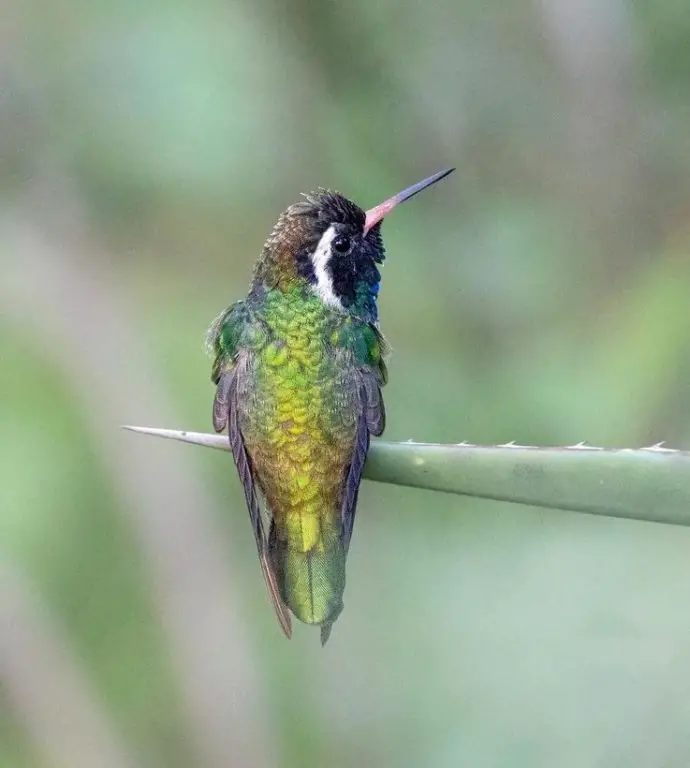
Photo by: jordanmartin_photography
Taken: Miller Canyon, AZ
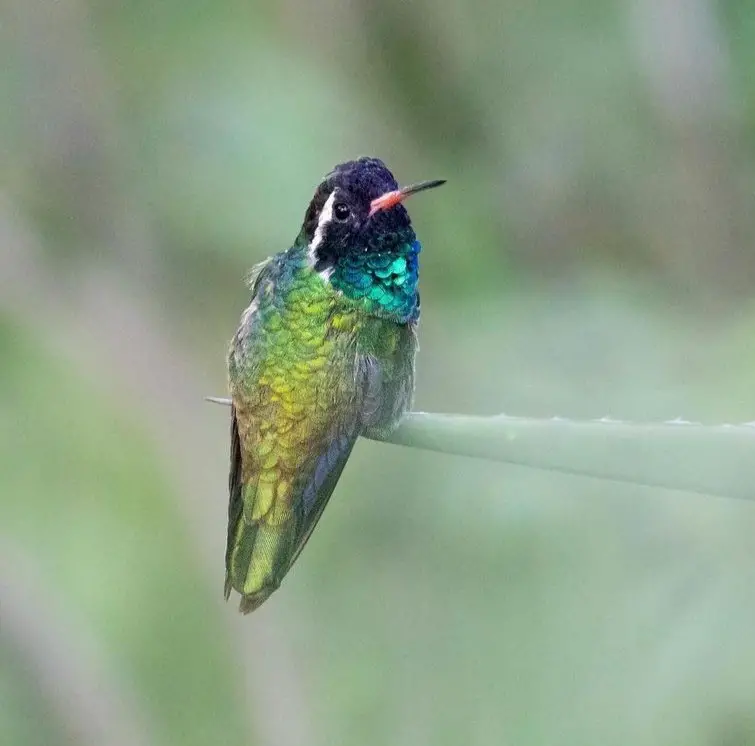
Photo by: jordanmartin_photography
Taken: Miller Canyon, AZ
Their habitat is mostly in the riparian woodlands and pine-oak woodlands of southeastern Arizona. These climates provide warm summers and colder winters with constant rainfall and humidity.
See pictures and hear sounds of White-eared hummingbirds here…..
Rare/Vagrant Hummingbirds
ALLEN’S HUMMINGBIRD – (Selasphorus sasin)
Conservation Status: Least concerned
Kingdom: Animalia
Phylum: Chordata
Class: Aves
Order: Apodiformes
Family: Trochilidae
Genus: Selasphorus
Species: S. sasin
The common name of Allen’s hummingbird is in commemoration of Charles Andrew Allen (1841-1930), an American collector and taxidermist.
Allen’s hummingbirds are rare migratory visitors to Arizona because they commonly reside and nest along the California coast and winter in Mexico. However, some continue their migration and wander farther east into Arizona, south into Texas and continue their journey as far as Florida being noted as rare migrants.
These rare sightings are mostly in July in southeastern Arizona with less sightings in northern and central Arizona.
Male Allen’s hummingbird shows an iridescent orange-red gorget. They are green backed with a green forehead and rust-colored flanks, rump, and tail. When their tail feathers are fanned out you can see their chocolate-colored tips. Allen’s hummingbirds are 3.3 inches to 3.5 inches in length and weigh 2-4 grams.
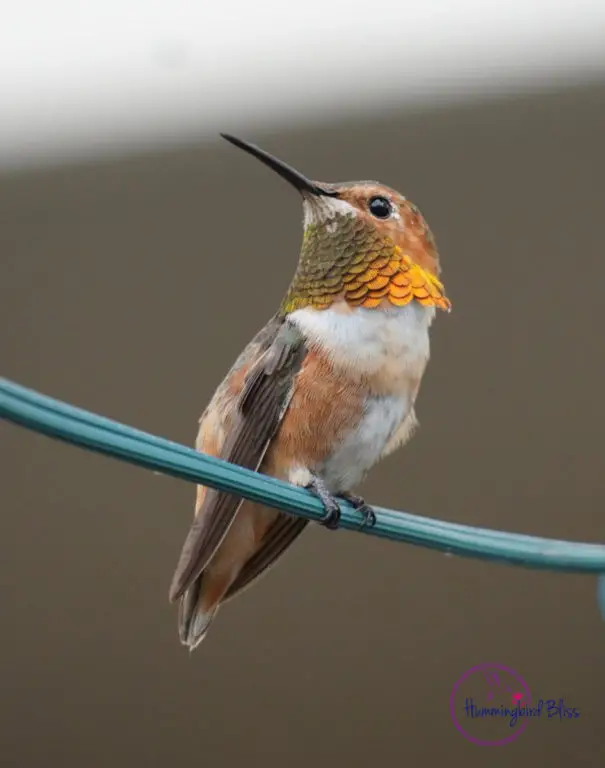
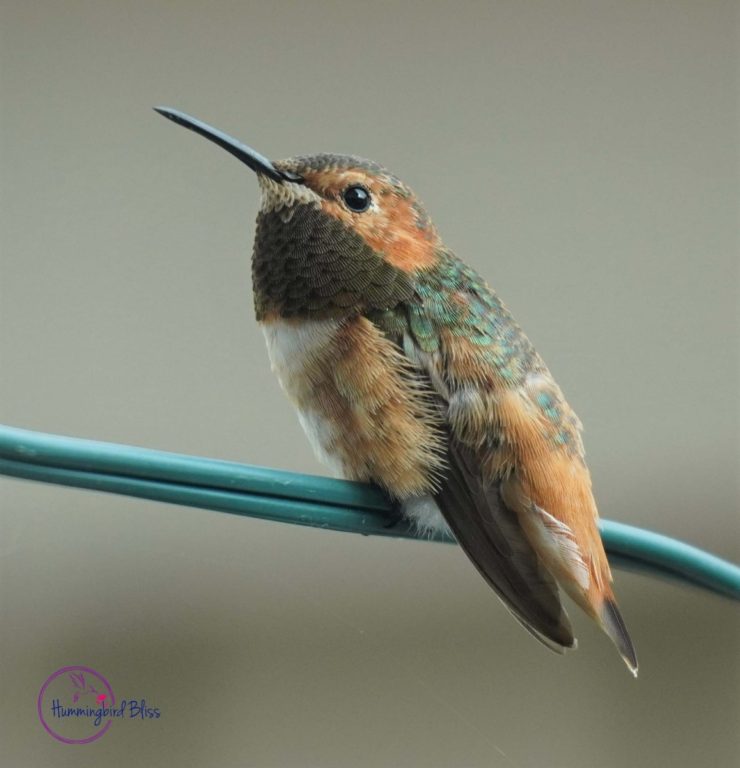
Females and juveniles Allen’s hummingbird have similar coloring as the males, but lack the iridescent gorget.
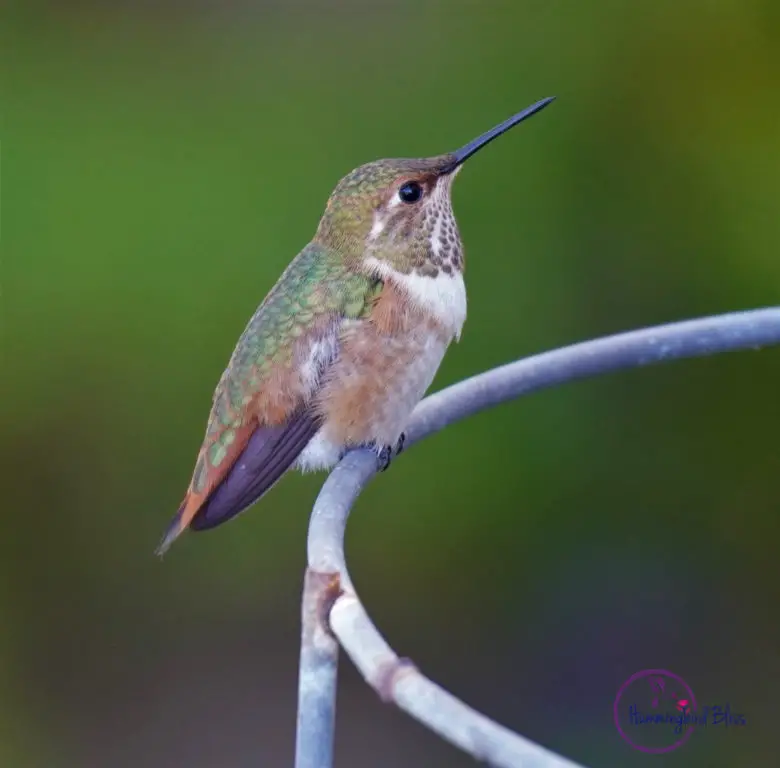
Note: On a tomato cage defending a feeder.
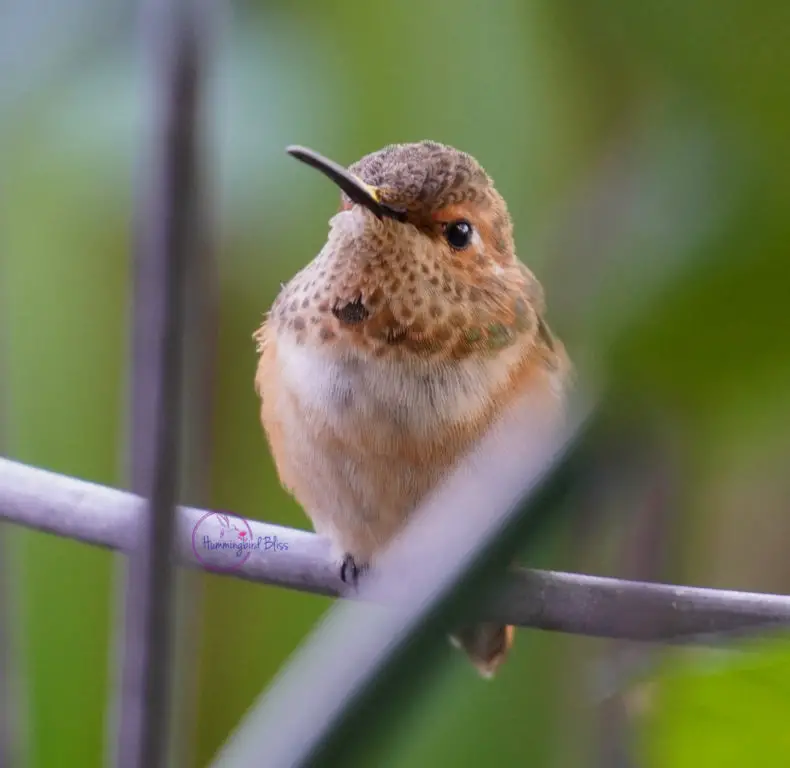
Note: On a tomato cage and hiding in a tomato plant near a feeder.
Juvenile Allen’s hummingbirds are so similar in coloring and temperament to a Rufous hummingbird that they are practically indistinguishable in the field. Therefore, identification is established by range rather than appearance.
Their nesting season is perfectly timed to when the regions have the most rainfall which helps provide prolific nectar producing flowers for their offspring.
Male Allen’s hummingbirds perform a striking, quick back-and-forth courtship dance resembling the movement of a pendulum. They have one of the most complex territorial dive displays of any North American hummingbird.
See my article Hummingbird Dance: 5 Interpretive Explanations…..
Male and female Allen’s hummingbirds are not social birds. They do not associate with one another outside of breeding. Similar to a Rufous hummingbird, Allen’s hummingbirds are highly territorial and can be aggressive not only towards other hummingbirds but will also attack any species; even larger predatory birds such as hawks.
Their habitat consists of open woodlands, dry chaparral vegetation consisting of dense shrubs, thorny bushes and riparian wetlands.
Allen’s hummingbirds are absent at mountainous elevations above 9,000 feet due to the lack of hummingbird flowers that would otherwise serve as their nectar source.
See pictures of male, female and juvenile Allen’s hummingbirds here…..
Hear sounds of Allen’s hummingbirds here…..
BERYLLINE HUMMINGBIRD – (Amazilia beryllina)
Berylline (pronounced: berra-line) hummingbirds gets its name from the Latin word beryllina meaning “green color” which stems from beryl, a colorless mineral. Known varieties of colored beryl are emerald and aquamarine gemstones that closely match the color of these birds.
They are vagrants and are rare local summer residents to Arizona since they are primarily found in Mexico. Their breeding habitat is in Central America among the lush tropical forests of western Mexico and Honduras. They are considered a non-migratory bird, however rare occasions have been documented where they have been seen in the Santa Rita, Huachuca and Chiricahua Mountains.
Male Berylline hummingbirds are identified by their bright iridescent emerald green crown and throat. The underbelly is a brownish beige hue. The wings are dark rich brown with nutmeg accents and their forked tail is a purplish red. They are a medium sized bird and are 3.1 to 3.9 inches in length. They weigh 4-5 grams.
Berylline hummingbirds are seen mostly in pine-oak woodland and sycamore streamside forests in the mountain canyons. They nest from July through September.
They are known to hybridize with the Rivoli’s (Magnificent) hummingbird, Azure-crowned hummingbird and the Blue-tailed hummingbird.
Their preferred habitats favor oak and pine from the woodlands along with tropical deciduous forests that provide heavy rainfall in the summers and dry winter topography.
See pictures and hear sounds of Berylline hummingbirds here…..
GREEN-VIOLETEARS HUMMINGBIRD – (Colibri thalassinus)
Conservation Status: Least concerned
Kingdom: Animalia
Phylum: Chordata
Class: Aves
Order: Apodiformes
Family: Trochilidae
Genus: Colibri
Species: C. thalassinus / Mexican violetear
The Green-violetears or Mexican-violetears (Violet-ear) hummingbird gets its name from the Latin word thalassinus meaning “color of the sea”. They are a rare/accidental hummingbird to Arizona because they are mostly a resident of Mexico and Central America. Recently, there have been some seasonal movements observed as they wander north into the United States and even as far north as Canada.
Male Green-violetear hummingbirds are iridescent green in color with a show of bright violet ear patches on each side of their neck (hence the name “violet-ears”). The tail of this hummingbird is metallic blue-green with bronze central tail feathers that feature a black band underneath. Their size ranges from 3.8 inches to 4.7 inches in length and they weigh 5-6 grams.
These species of hummingbirds are found on the edge of cloud forests from Mexico to Nicaragua where they enjoy a high level of tropical humidity in their environment. This dark hummingbird is commonly seen in forest edges and clearings.
Green-violetear hummingbirds are somewhat nomadic. Scientists do not know much about their migration patterns as they have not been well-studied. But of the data that has been collected, the Mexican Violetear is typically found in central Mexico, central America, and northern South America.
Individual Mexican-violetears have been identified as strays as far north as Wisconsin, Michigan, and even Canada.
Like many other kinds of hummingbirds, the Green-violetears hummingbird is a solitary nester. They forage for nectar and insects alone rather than in a flock, but groups of these hummingbirds can be seen around flowering trees, such as the coffee-shade Inga tree.
See pictures and hear sounds of Mexican violet-ear hummingbirds here…..
LUCIFER HUMMINGBIRD – (Calothorax lucifer)
Conservation Status: Least concerned
Kingdom: Animalia
Phylum: Chordata
Class: Aves
Order: Apodiformes
Family: Trochilidae
Genus: Calothorax
Species: C. lucifer
The Lucifer hummingbird gets its name from the Latin word “Lucifer” referring to the morning star of the planet Venus or luminous light. The correlation is referring or describing the male’s iridescent gorget.
Lucifer hummingbirds are generally rare visitors throughout the United States but are specifically rare in Arizona and New Mexico. If they are spotted, it is usually in March for the breeding season and they return south to Mexico by October. They are seen in the higher elevations of 3,500-5,500 feet and enjoy the agave covered foothills.
Male Lucifer hummingbirds have an iridescent royal purple gorget flaring down on both sides of the throat. They have a white breast, green crown and backs, with a slightly curved bill. Their tails are deeply forked and are only visible when their tail feathers are flared or wide when maneuvering flight. They grow to 3.5 inches in length and weigh 3-4 grams.
Females Lucifer hummingbirds have a curved bill, green crowns, back with dark chocolate dorsal wings, and a cinnamon-buffy underbelly. They sport a small smudge of brown below their eyes. Their tails are shorter than the males.
These hummingbirds are most adaptable to desert regions where their nests are located on Cane Cholla (a type of cactus), Ocotillo (looks like a cactus, but not a true cactus) and Agave lechugilla “stalks” (succulent plant ) that grow 2-15 feet above the ground. These plants have height and strength in their flexible stalks that grow high above the ground. This makes a unique and perfect location for building a nest safe and inconspicuous from predators.
See pictures of male, female and juvenile Lucifer hummingbirds here…..
Hear sounds of Lucifer hummingbirds here…..
RUBY-THROATED HUMMINGBIRD – (Archilochus colubris)
Conservation Status: Least concerned
Kingdom: Animalia
Phylum: Chordata
Class: Aves
Order: Apodiformes
Family: Trochilidae
Genus: Archilochus
Species: A. colubris
Ruby-throated hummingbirds are very rare to Arizona since their main residence is mostly in the Midwest and on the east coast. There has been only one adult female recorded in 2005 in Tucson, one adult male sighting in 2007 and 2008 in Patagonia, southern Arizona with no subsequent recorded sightings.
Male Ruby-throated hummingbirds have a striking iridescent blood-red gorget, stopping at the neckline. He is identified with a dull metallic green topside, a light gray underbelly and black wings. The Ruby-throated hummingbird is a smaller species of hummingbirds weighing less than 4.5 grams or 2 U.S. dimes and is 2.8 to 3.3 inches in length. Their lifespan is approximately 5 years.
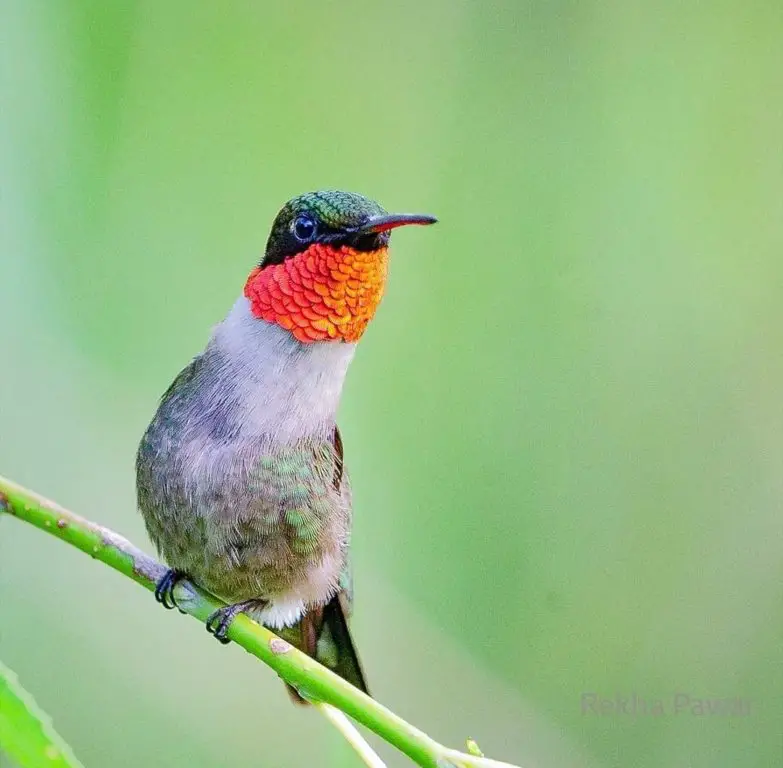
Photo by: Rekha Pawar
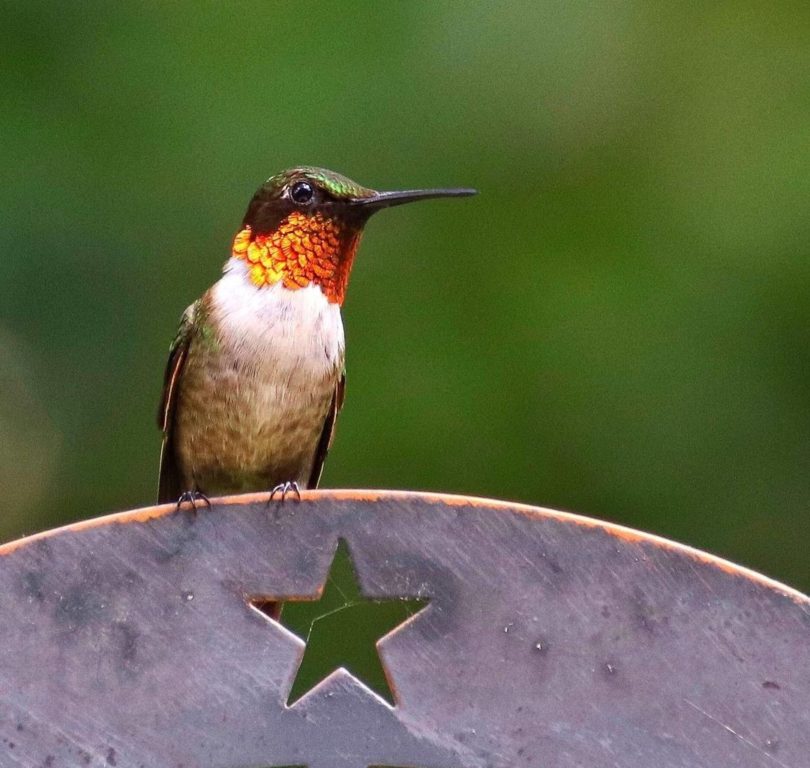
Photo by: paulapaintsart
Female Ruby-throated hummingbirds have a white throat with some light stippling and are typically larger than the males. Their lifespan is approximately 9 years, almost double that of the male.
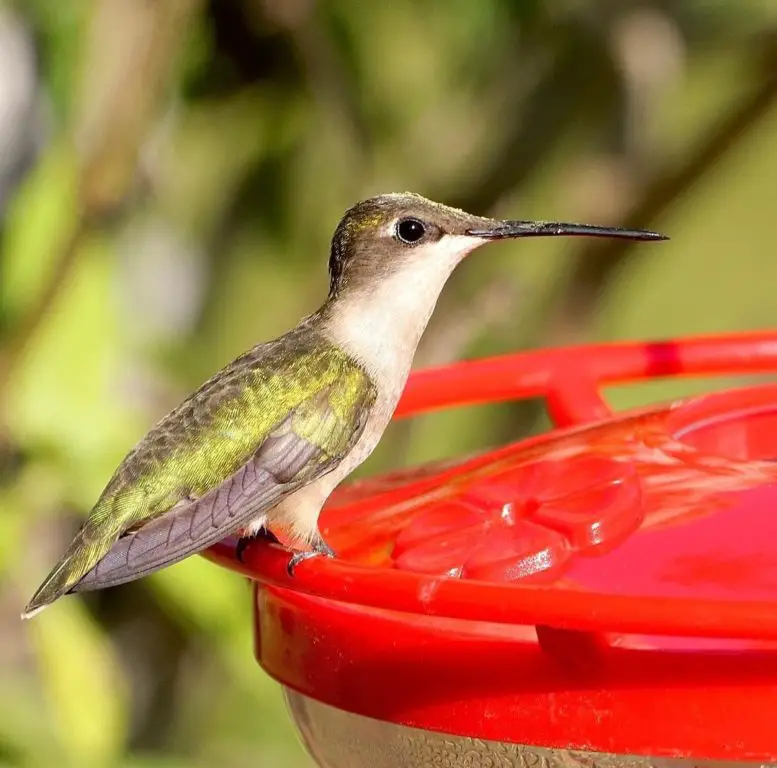
Photo by: dgen.photos
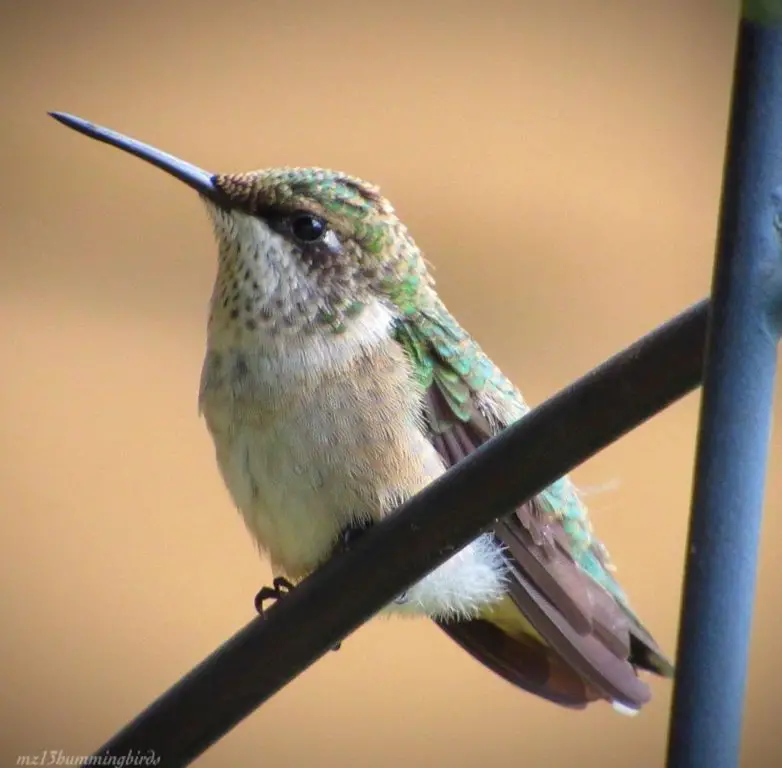
Photo by: mz13hummingbirds
Note: The newly white fluffy down feathers near its bottom.
Ruby-throated hummingbirds arrive in Arizona in the spring around March if they are seen since they are very rare in Arizona. They will begin migrating south for the winter towards Mexico and may continue to travel to Costa Rica as early as the end of July to the middle of November.
Researchers believe their small size makes the energy expenditure of their grueling trans-oceanic migration pattern more taxing for males than for females even though they both double their body’s fat prior to making the migration across the Gulf of Mexico.
Ruby-throated hummingbirds prefer open woodlands and are often seen in parks, gardens, and backyards. They are solitary birds except during mating periods when they are fiercely territorial and aggressive towards hummingbirds of other species. Even though these hummingbirds have an aggressive side they can still be eaten by predators such as large invertebrates, praying mantises, orb-weaver spiders, and dragonflies.
See pictures of male, female, and juvenile Ruby-throated hummingbirds here…..
Hear sounds of Ruby-throated hummingbirds here…..
VIOLET-CROWNED HUMMINGBIRD – (Amazilia voliceps)
Conservation Status: Least concerned
Kingdom: Animalia
Phylum: Chordata
Class: Aves
Order: Apodiformes
Family: Trochilidae
Genus: Amazilia
Species: A. voliceps
Violet-crowned hummingbirds derive their name from the bright purple cap of feathers on its head known as a crown.
They are rare to Arizona and if spotted are in the higher elevations of the Madrean Sky Islands as well as in the mountain ranges of Miller Peak, the canyons of Huachuca and Tucson Audubon’s Paton Center for Hummingbirds. They usually breed between July and September mostly in Mexico and in the southwestern to south central United States.
Male Violet-crowned hummingbirds have a reddish-orange beak with a noticeable black tip. They sport a cap of iridescent violet-blue iridescent feathers that transcend around the eyes to resemble a mask similar to the character Zorro. They have olive green on their back topsides. Their underbelly is a distinguishable bright white starting from their chin down the full length of their body. These hummingbirds are 3 to 3.9 inches in length and weigh 5 grams.
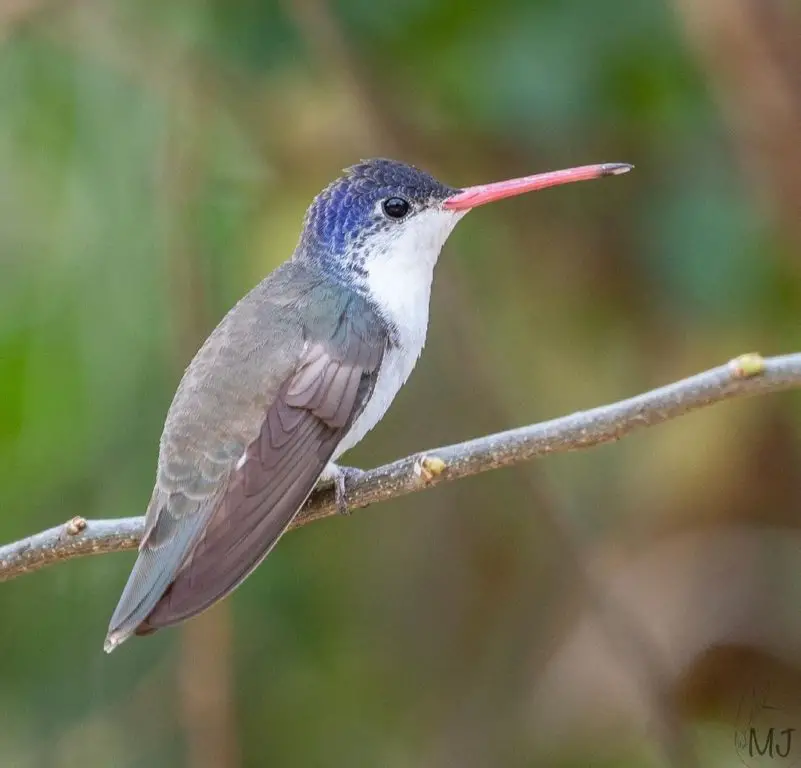
Photo by: hummingbirdsbysuprise
Taken: Arizona
Unlike many hummingbird species, Violet-crowned hummingbirds have neither a gorget nor ear patch markings.
Female Violet-crowned hummingbirds as usual are drabber looking than the males.
Violet-crowned hummingbirds prefer a riparian habitat, which means they can be found in woodland areas near rivers. There is an increase in these hummingbirds over-wintering in the southern United States, including Texas, expanding its habitat range annually as it slowly expands northward.
See pictures and hear sounds of Violet-crowned hummingbirds here…..
Leucistic Hummingbirds in Arizona
Leucistic hummingbirds are a form of albinism producing less pigment in color and displaying patchy or irregular colorations of grey, brown, tan or beige than pure albino hummingbirds.
Rare Leucistic hummingbirds sightings are infrequent in general, however Leucistic hummingbirds have been witnessed in Arizona. Below are some documented sightings.
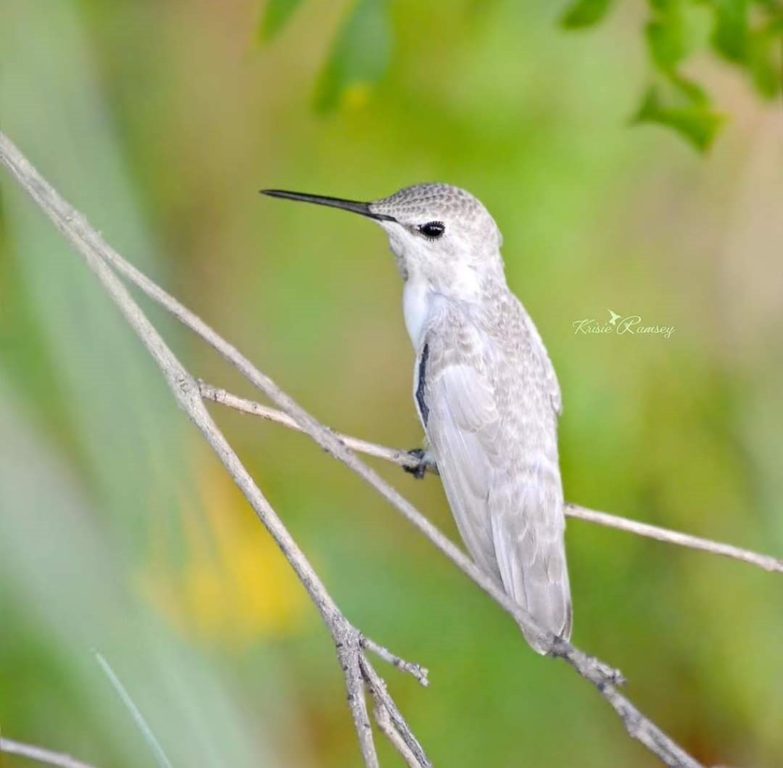
Photo by: krisieramsey
Taken: Tempe, Arizona
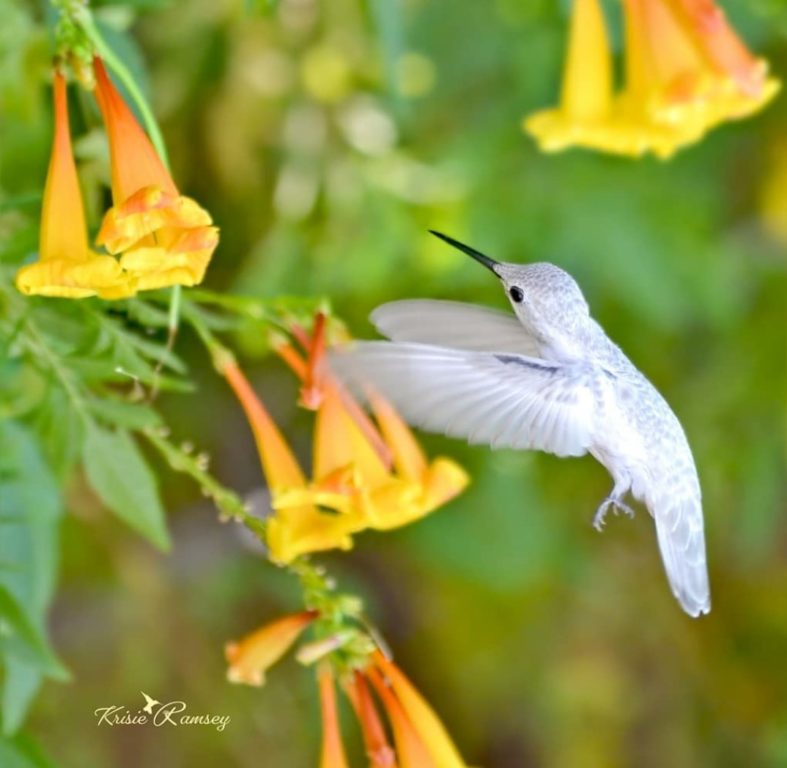
Photo by: krisieramsey
Taken: Tempe, Arizona
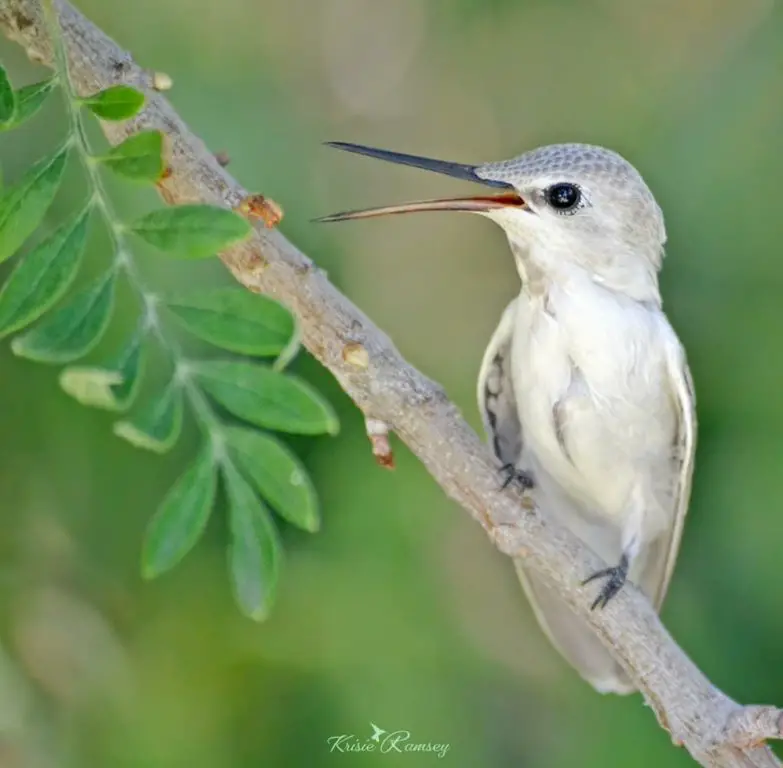
Photo by: krisieramsey
Taken: Tempe, Arizona
To learn more about the differences between Albino and Leucistic hummingbirds See my article: Are There White Hummingbirds?
For any ill, injured or distressed hummingbirds in Phoenix, Arizona contact:
Liberty Wildlife
2600 E. Elwood St
Phoenix, Arizona 85040
Phone: (480) 998-5550
Happy Hummingbird Watching!
Backyard Visitors is a participant in the Amazon Services LLC Associates Program, an affiliate advertising program designed to provide a means for sites to earn advertising fees by advertising and linking to Amazon.com. We also participate in other affiliate programs which compensate us for referring traffic.
